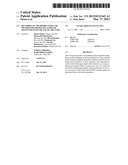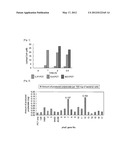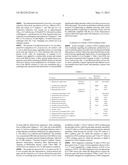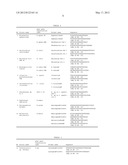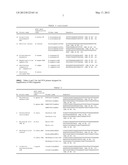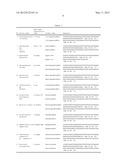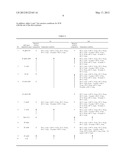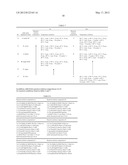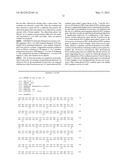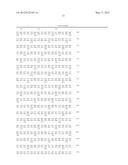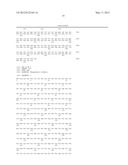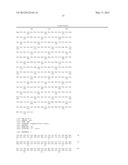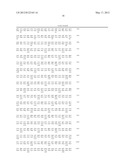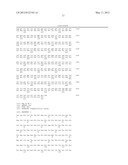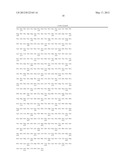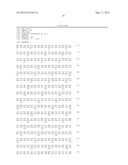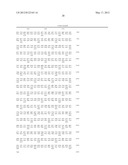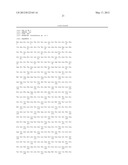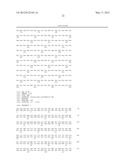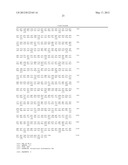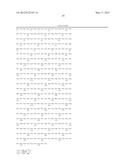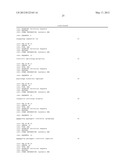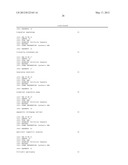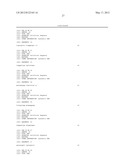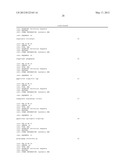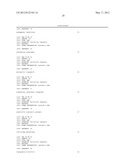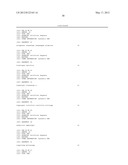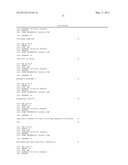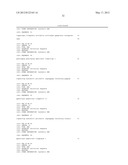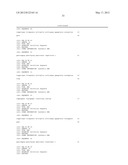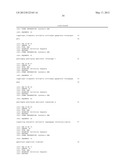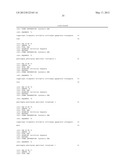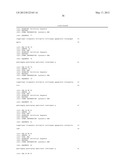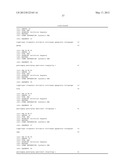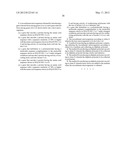Patent application title: RECOMBINANT MICROORGANISM AND METHOD FOR PRODUCING ALIPHATIC POLYESTER WITH THE USE OF THE SAME
Inventors:
Shusei Obata (Nagoya-Shi, JP)
Shusei Obata (Nagoya-Shi, JP)
Masayoshi Muramatsu (Miyoshi-Shi, JP)
Masayoshi Muramatsu (Miyoshi-Shi, JP)
Hiromi Kambe (Seto-Shi, JP)
Masakazu Ito (Toyota-Shi, JP)
Masakazu Ito (Toyota-Shi, JP)
Takashi Shimamura (Toyota-Shi, JP)
Katsunori Kohda (Nisshin-Shi, JP)
Assignees:
TOYOTA JIDOSHA KABUSHIKI KAISHA
IPC8 Class: AC12P762FI
USPC Class:
435135
Class name: Micro-organism, tissue cell culture or enzyme using process to synthesize a desired chemical compound or composition preparing oxygen-containing organic compound carboxylic acid ester
Publication date: 2012-05-17
Patent application number: 20120122165
Abstract:
This invention provides a recombinant microorganism exhibiting excellent
aliphatic polyester productivity and a method for producing an aliphatic
polyester with the use of the recombinant microorganism. In this
invention, the Megasphaera elsdenii-derived pct gene (and/or the
Staphylococcus aureus-derived pct gene) and the Pseudomonas sp. 61-3
strain-derived PHA synthase gene (phaC2 gene) (and/or the Alcanivorax
borkumensis SK2 strain-derived PHA synthase gene) are introduced into a
host microorganism.Claims:
1. A recombinant microorganism obtained by introducing a gene selected
from among genes (a) to (c) and a gene selected from among genes (d) to
(f) shown below into a host microorganism: (a) a gene that encodes a
protein having the amino acid sequence shown in SEQ ID NO: 2 or 4; (b) a
gene that encodes a protein having an amino acid sequence with a sequence
similarity of 70% or higher with the amino acid sequence shown in SEQ ID
NO: 2 or 4 and having activity of converting lactic acid into lactate
CoA; (c) a gene that hybridizes to a polynucleotide having a nucleotide
sequence complementary to the nucleotide sequence shown in SEQ ID NO: 1
or 3 under stringent conditions and encodes a protein having activity of
converting lactic acid into lactate CoA; (d) a gene that encodes a
protein having the amino acid sequence shown in SEQ ID NO: 6 or 8; (e) a
gene that encodes a protein having an amino acid sequence with a sequence
similarity of 70% or higher with the amino acid sequence shown in SEQ ID
NO: 6 or 8 and having activity of synthesizing polylactate with the use
of lactate CoA as a substrate; and (f) a gene that hybridizes to a
polynucleotide having a nucleotide sequence complementary to the
nucleotide sequence shown in SEQ ID NO: 5 or 7 under stringent conditions
and encodes a protein having activity synthesizing polylactate with the
use of lactate CoA as a substrate.
2. The recombinant microorganism according to claim 1, wherein the host microorganism is Escherichia coli.
3. A method for producing an aliphatic polyester, comprising culturing the recombinant microorganism according to claim 1 in a medium and collecting an aliphatic polyester.
4. The method for producing an aliphatic polyester according to claim 3, wherein the aliphatic polyester to be collected is an aliphatic polyester having a lactic acid skeleton.
5. The method for producing an aliphatic polyester according to claim 3, wherein the aliphatic polyester to be collected is polylactate.
6. The method for producing an aliphatic polyester according to claim 3, wherein lactic acid is not added to the medium when the recombinant microorganism is cultured.
Description:
TECHNICAL FIELD
[0001] The present invention relates to a recombinant microorganism to which desired functions have been imparted by introducing a predetermined gene into a host microorganism and a method for producing an aliphatic polyester with the use of the same.
BACKGROUND ART
[0002] Aliphatic polyesters have been gaining attention as biodegradable plastics that can be readily degraded in nature or as "green plastics" that can be synthesized from reproducible carbon resources such as sugar or plant oil. At present, aliphatic polyesters having lactic acid skeletons (e.g., polylactate) have been used in practice.
[0003] The technique disclosed in, for example, Patent Document 1 (WO 2006/126796) has been known as a technique of producing an aliphatic polyester such as polylactate with the use of a recombinant microorganism. Patent Document 1 discloses recombinant Escherichia coli obtained by introducing a gene encoding an enzyme that converts lactic acid into lactate CoA and a gene encoding an enzyme that synthesizes polyhydroxyalkanoate with the use of lactate CoA as a substrate into Escherichia coli serving as a host. In the technique disclosed in Patent Document 1, the Clostridium propionicum-derived pct gene is used as a gene encoding an enzyme that converts lactic acid into lactate CoA. In addition, in such case, the Pseudomonas sp. 61-3 strain-derived phaC2 gene is used as a gene encoding an enzyme that synthesizes polyhydroxyalkanoate with the use of lactate CoA as a substrate.
[0004] Nevertheless, it cannot be said that a sufficient level of productivity regarding aliphatic polyester such as polylactate is achieved in the case of Patent Document 1. Further, sufficient discussion on the improvement of such productivity has not yet been carried out. For example, Patent Document 2 (WO 2008/062999) discloses an attempt to improve the capacity to synthesize a lactic acid homopolymer or polylactate copolymer with the use of lactate CoA as a substrate by introducing a specific mutation into the Pseudomonas sp. 6-19 strain-derived phaC1 gene.
[0005] Meanwhile, the Megasphaera elsdenii-derived gene (propionyl-CoA transferase gene (pct gene)) has been disclosed as a gene encoding an enzyme that converts lactic acid into lactate CoA in, for example, Patent Document 3 (U.S. Pat. No. 7,186,541). However, in Patent Document 3, there is no examination or comparison of the activity levels of a variety of propionyl-CoA transferase genes. In addition, Patent Document 3 does not disclose a technique involving the use of the above gene upon production of aliphatic polyester as disclosed in Patent Document 1.
CITATION LIST
Patent Literature
[0006] PTL 1: Patent Document 1: WO 2006/126796 [0007] PTL 2: Patent Document 2: WO 2008/062999 [0008] PTL 3: Patent Document 3: U.S. Pat. No. 7,186,541
SUMMARY OF INVENTION
Technical Problem
[0009] As described above, the technique of producing an aliphatic polyester such as polylactate with the use of a recombinant microorganism has been problematic in terms of low aliphatic polyester productivity. In addition, it cannot be said that the technique has been sufficiently examined in view of the improvement of productivity. Therefore, it is an object of the present invention to provide a recombinant microorganism that exhibits excellent aliphatic polyester productivity and a method for producing aliphatic polyester with the use of such recombinant microorganism.
Solution to Problem
[0010] As a result of intensive studies in order to achieve the above object, the present inventors have found that a recombinant microorganism into which a predetermined microorganism-derived propionyl-CoA transferase gene and a predetermined microorganism-derived polyhydroxyalkanoate synthase gene have been introduced has significantly excellent productivity regarding aliphatic polyester such as polylactate. This has led to the completion of the present invention.
[0011] Specifically, the present invention encompasses the following.
[0012] Recombinant microorganisms of the present invention are obtained by introducing a gene selected from among genes (a) to (c) and a gene selected from among genes (d) to (f) shown below into a host microorganism:
[0013] (a) a gene that encodes a protein having the amino acid sequence shown in SEQ ID NO: 2 or 4;
[0014] (b) a gene that encodes a protein having an amino acid sequence derived from the amino acid sequence shown in SEQ ID NO: 2 or 4 by substitution, deletion, or addition of 1 or more amino acid(s) and having activity of converting lactic acid into lactate CoA;
[0015] (c) a gene that hybridizes to a polynucleotide having a nucleotide sequence complementary to the nucleotide sequence shown in SEQ ID NO: 1 or 3 under stringent conditions and encodes a protein having activity of converting lactic acid into lactate CoA;
[0016] (d) a gene that encodes a protein having the amino acid sequence shown in SEQ ID NO: 6 or 8;
[0017] (e) a gene that encodes a protein having an amino acid sequence derived from the amino acid sequence shown in SEQ ID NO: 6 or 8 by substitution, deletion, or addition of 1 or more amino acid(s) and having activity of synthesizing polylactate with the use of lactate CoA as a substrate; and
[0018] (f) a gene that hybridizes to a polynucleotide having a nucleotide sequence complementary to the nucleotide sequence shown in SEQ ID NO: 5 or 7 under stringent conditions and encodes a protein having activity synthesizing polylactate with the use of lactate CoA as a substrate.
[0019] Particularly preferably, the recombinant microorganism of the present invention is obtained with the use of Escherichia coli as a host microorganism. In addition, the recombinant microorganism of the present invention may be a microorganism into which not only the two above genes but also a gene encoding an enzyme involved in the aliphatic polyester synthesis system have been introduced. A recombinant microorganism into which the two above genes have been introduced can synthesize a polylactate homopolymer with the use of a carbon source in a medium. A recombinant microorganism into which not only the two above genes but also a gene encoding an enzyme involved in the aliphatic polyester synthesis system have been introduced can synthesize lactic acid copolymer with the use of a carbon source in a medium. Herein, the term "lactic acid copolymer" refers to a polymer having a polymer skeleton comprising a lactic acid skeleton and a non-lactic-acid hydroxyalkanoate skeleton.
[0020] In addition, according to the present invention, the aforementioned method for producing an aliphatic polyester with the use of the recombinant microorganism of the present invention can be provided. Specifically, the method for producing an aliphatic polyester of the present invention comprises the steps of culturing a microorganism and collecting an aliphatic polyester from a medium.
Advantageous Effects of Invention
[0021] According to the present invention, a recombinant microorganism having an excellent aliphatic polyester-producing capacity can be provided. Specifically, the recombinant microorganism of the present invention has significantly excellent aliphatic polyester-producing capacity compared with a conventional recombinant microorganism. With the use of the recombinant microorganism of the present invention, a method for producing an aliphatic polyester with excellent productivity can be provided.
BRIEF DESCRIPTION OF DRAWINGS
[0022] FIG. 1 is a characteristic diagram showing the evaluation results regarding the activity of converting lactic acid into lactate CoA for the Clostridium propionicum-derived propionyl-CoA transferase gene, the Megasphaera elsdenii-derived propionyl-CoA transferase gene, and the Staphylococcus aureus-derived propionyl-CoA transferase gene.
[0023] FIG. 2 is a characteristic diagram showing the evaluation results regarding polylactate productivity for a variety of polyhydroxyalkanoate synthase genes expressed with the Megasphaera elsdenii-derived propionyl-CoA transferase gene.
DESCRIPTION OF EMBODIMENTS
[0024] Hereinafter, the recombinant microorganism and the method for producing an aliphatic polyester using the same of the present invention are described in detail.
[0025] The recombinant microorganism of the present invention is obtained by introducing a predetermined propionyl-CoA transferase gene (pct gene) and a predetermined polyhydroxyalkanoate synthase gene into a host microorganism.
[0026] Propionyl-CoA Transferase Gene
[0027] In the present invention, examples of propionyl-CoA transferase genes (hereinafter referred to as pct genes(s)) include a Megasphaera elsdenii-derived gene and a Staphylococcus aureus-derived gene. SEQ ID NO: 1 shows the nucleotide sequence of the coding region of the Megasphaera elsdenii-derived pct gene. SEQ ID NO: 2 shows the amino acid sequence of a protein encoded by such pct gene. In addition, SEQ ID NO: 3 shows the nucleotide sequence of the coding region of the Staphylococcus aureus-derived pct gene. SEQ ID NO: 4 shows the amino acid sequence of a protein encoded by such pct gene. A protein having the amino acid sequence shown in SEQ ID NO: 2 or 4 has propionyl-CoA transferase activity, and particularly activity of synthesizing lactate CoA with the use of lactic acid as a substrate.
[0028] In addition, examples of a pct gene of the present invention are not limited to a gene having the nucleotide sequence encoding the amino acid sequence shown in SEQ ID NO: 2 or 4 and may include a gene encoding a protein having an amino acid sequence derived from the amino acid sequence by deletion, substitution, or addition of 1 or more amino acid(s) and having activity of converting lactic acid into lactate CoA. Herein, the term "1 or more amino acid(s)" refers to, for example, 1 to 20, preferably 1 to 10, more preferably 1 to 7, further preferably 1 to 5, and particularly preferably 1 to 3 amino acids.
[0029] Further, a pct gene of the present invention may be a gene that encodes a protein having an amino acid sequence with a sequence similarity of, for example, 70% or higher, preferably 80% or higher, more preferably 90% or higher, and most preferably 95% or higher with the amino acid sequence shown in SEQ ID NO: 2 or 4 and having activity of converting lactic acid into lactate CoA. Herein, the sequence similarity value refers to the value obtained in the default setting with the use of a computer program implemented with the BLAST algorithm and a database containing gene sequence information.
[0030] Furthermore, a pct gene of the present invention may be a gene which has a polynucleotide that hybridizes to at least a portion of a gene having the nucleotide sequence shown in SEQ ID NO: 1 or 3 under stringent conditions and encodes a protein having activity of converting lactic acid into lactate CoA. Herein, the term "under stringent conditions" refers to what are called conditions that cause formation of a specific hybrid but not a non-specific hybrid. For instance, conditions of hybridization with 6×SSC (sodium chloride/sodium citrate) at 45 degrees C. and subsequent washing with 0.2 to 1×SSC and 0.1% SDS at 50 degrees C. to 65 degrees C. can be referred to. Alternatively, conditions of hybridization with 1×SSC at 65 degrees C. to 70 degrees C. and subsequent washing with 0.3×SSC at 65 degrees C. to 70 degrees C. can be referred to as such conditions. Hybridization can be carried out by a conventionally known method such as the method described in J. Sambrook et al. Molecular Cloning, A Laboratory Manual, 2nd Ed., Cold Spring Harbor Laboratory (1989).
[0031] In addition, deletion, substitution, or addition of amino acid(s) can be carried out by a technique known in the art by modifying a nucleotide sequence encoding a transcription factor described above. Mutagenesis in a nucleotide sequence can be caused by a known method such as the Kunkel method, the gapped duplex method, or a method similar to such a known method. For instance, mutagenesis can be caused with the use of a mutagenesis kit (e.g., Mutant-K or Mutant-G (product name, TAKARA Bio)) based on a site-directed mutagenesis method, an LA PCR in vitro Mutagenesis series kit (product name, TAKARA Bio), or the like. Alternatively, a mutagenesis method may be a method using a chemical mutagen represented by EMS (ethyl methanesulfonate), 5-bromouracil, 2-aminopurine, hydroxylamine, N-methyl-N'-nitro-N-nitrosoguanidine, or a different carcinogenic compound, a method comprising radiation treatment using radioactive rays such as X-rays, alpha-rays, beta-rays, gamma-rays, or an ion beam, or a method comprising ultraviolet treatment.
[0032] Polyhydroxyalkanoate Synthase Gene
[0033] Polyhydroxyalkanoate synthase genes (also referred to as PHA synthase genes) are known to exist in many microorganisms, as disclosed in Patent Document 1 (WO 2006/126796). Particularly in the present invention, a specific polyhydroxyalkanoate synthase gene is expressed in a host microorganism with a pct gene described above. Specifically, as a polyhydroxyalkanoate synthase gene used in the present invention, the Pseudomonas sp. 61-3 strain-derived polyhydroxyalkanoate synthase gene (phaC2 gene) and/or the Alcanivorax borkumensis SK2 strain-derived polyhydroxyalkanoate synthase gene can be used. SEQ ID NO: 5 shows the nucleotide sequence of the coding region of the Pseudomonas sp. 61-3 strain-derived polyhydroxyalkanoate synthase gene (phaC2 gene). SEQ ID NO: 6 shows the amino acid sequence of a protein encoded by the phaC2 gene. In addition, SEQ ID NO: 7 shows the nucleotide sequence of the coding region of the Alcanivorax borkumensis SK2 strain-derived polyhydroxyalkanoate synthase gene. SEQ ID NO: 8 shows the amino acid sequence of a protein encoded by the polyhydroxyalkanoate synthase gene. A protein having the amino acid sequence shown in SEQ ID NO: 6 or 8 has polyhydroxyalkanoate-synthesizing activity, and particularly activity of synthesizing polylactate with the use of lactate CoA as a substrate or activity of synthesizing a polylactate-based copolymer with the use of lactate CoA and a different hydroxyalkanoate as a substrate.
[0034] In addition, examples of a PHA synthase gene of the present invention are not limited to a gene having the nucleotide sequence encoding the amino acid sequence shown in SEQ ID NO: 6 or 8 and may include a gene encoding a protein having an amino acid sequence derived from the amino acid sequence by deletion, substitution, or addition of 1 or more amino acid(s) and having activity of synthesizing polylactate with the use of lactate CoA as a substrate. Herein, the term "1 or more amino acid(s)" refers to, for example, 1 to 20, preferably 1 to 10, more preferably 1 to 7, and further preferably 1 to 5, and particularly preferably 1 to 3 amino acid(s).
[0035] Further, a PHA synthase gene of the present invention may be a gene that encode a protein having an amino acid sequence with a sequence similarity of, for example, 70% or higher, preferably 80% or higher, more preferably 90% or higher, and most preferably 95% or higher with the amino acid sequence shown in SEQ ID NO: 6 or 8 and having activity of synthesizing polylactate with the use of lactate CoA as a substrate. Herein, the sequence similarity value refers to the value obtained in the default setting with the use of a computer program implemented with the BLAST algorithm and a database containing gene sequence information.
[0036] Furthermore, a PHA synthase gene of the present invention may be a gene which has a polynucleotide that hybridizes to at least a portion of a gene having the nucleotide sequence shown in SEQ ID NO: 5 or 7 under stringent conditions and encodes a protein having activity of synthesizing polylactate with the use of lactate CoA as a substrate. In addition, the term "stringent conditions" refers to the same as defined in the paragraph describing "the propionyl-CoA transferase gene".
[0037] Also, techniques exemplified in the paragraph describing "the propionyl-CoA transferase gene" can be used for amino acid deletion, substitution, or addition.
[0038] Host Microorganisms
[0039] Examples of a host microorganisms of the present invention include: bacteria belonging to the genus Pseudomonas, such as the Pseudomonas sp. 61-3 strain; bacteria belonging to the genus Ralstonia, such as R. eutropha; bacteria belonging to the genus Bacillus, such as Bacillus subtilis; bacteria belonging to the genus Escherichia, such as Escherichia coli; bacteria belonging to the genus Corynebacterium; yeasts belonging to the genus Saccharomyces, such as Saccharomyces cerevisiae; and yeasts belonging to the genus Candida, such as Candida maltosa. It is particularly preferable to use Escherichia coli as a host microorganism.
[0040] A vector used for introduction of the aforementioned genes into a host cell can be a vector capable of autonomously replicating in a host, which is preferably in the form of plasmid DNA or phage DNA. Examples of a vector to be introduced into Escherichia coli include: plasmid DNAs such as pBR322, pUC18, and pBLuescript II; and phage DNAs such as EMBL3, M13, and lambda-gtII. Examples of a vector to be introduced into a yeast include YEp13 and YCp50.
[0041] Insertion of both or either of the aforementioned genes into a vector can be carried out using a gene recombinant technique known by those in the art. In addition, upon recombination, it is preferable to ligate the gene(s) downstream of a promoter capable of regulating transcription. Any promoter can be used as long as it can regulate gene transcription in a host. For instance, in a case in which Escherichia coli is used as a host, a trp promoter, a lac promoter, a PL promoter, a PR promoter, a T7 promoter, or the like can be used. In a case in which a yeast is used as a host, a gal1 promoter, a gal10 promoter, or the like can be used.
[0042] Further, a terminator sequence, an enhancer sequence, a splicing signal sequence, a poly-A addition signal sequence, a ribosome binding sequence (SD sequence), a selection marker gene, and the like, which can be used in a microorganism used for gene introduction, can be ligated to a vector according to need. Examples of a selection marker gene include a gene involved in intracellular biosynthesis of a nutrient such as an amino acid or a nucleic acid and a gene encoding a fluorescent protein such as luciferase, in addition to drug-resistant genes such as an ampicillin-resistant gene, a tetracycline-resistant gene, a neomycin-resistant gene, a kanamycin-resistant gene, and a chloramphenicol-resistant gene.
[0043] The above vector can be introduced into a microorganism by a method known by those in the art. Examples of a method for introducing a vector into a microorganism include a calcium phosphate method, an electroporation method, a spheroplast method, a lithium acetate method, a conjugal transfer method, and a method using calcium ions.
[0044] Production of Aliphatic Polyester
[0045] An aliphatic polyester of interest can be produced by culturing a recombinant microorganism obtained by introducing a pct gene and a PHA synthase gene described above into a host microorganism in a medium containing a carbon source so as to cause generation and accumulation of aliphatic polyester in culture bacterial cells or a culture, followed by collection of aliphatic polyester from the culture bacterial cells or the culture. The above recombinant microorganism synthesizes lactic acid from a sugar in a sugar metabolism pathway and then propionyl-CoA transferase encoded by the pct gene converts lactic acid into lactate CoA. In addition, in the recombinant microorganism, PHA synthase encoded by the PHA synthase gene synthesizes an aliphatic polyester comprising lactic acid as a building block with the use of lactate CoA as a substrate. Herein, an aliphatic polyester may be polylactate (homopolymer) comprising a building block consisting of lactic acid or a lactic acid-based copolymer comprising a building block consisting of lactic acid and non-lactic-acid hydroxyalkanoate. When polylactate (homopolymer) is synthesized, non-lactic-acid hydroxyalkanoate is not added to a medium, or a host microorganism is caused to lack a non-lactic-acid hydroxyalkanoate biosynthesis pathway. Meanwhile, when a lactic acid-based copolymer comprising a building block consisting of lactic acid and non-lactic-acid hydroxyalkanoate is synthesized, non-lactic-acid hydroxyalkanoate can be added to a medium, or a host microorganism is allowed to have a non-lactic-acid hydroxyalkanoate biosynthesis pathway.
[0046] Examples of carbon sources include carbohydrates such as glucose, fructose, sucrose, and maltose. In addition, a fat-and-oil-related substance with a carbon number of 4 or higher can be used as a carbon source. Examples of a fat-and-oil-related substance with a carbon number of 4 or higher include: natural fat and oil such as corn oil, soybean oil, safflower oil, sunflower oil, olive oil, coconut oil, palm oil, rapeseed oil, fish oil, whole oil, pig oil, or bovine oil; fatty acid such as butanoic acid, pentanoic acid, hexanoic acid, octanoic acid, decanoic acid, lauric acid, oleic acid, palmitic acid, linolenic acid, linoleic acid, myristic acid, or a fatty acid ester thereof; and alcohol such as octanol, lauryl alcohol, oleyl alcohol, palmityl alcohol, or an ester thereof.
[0047] Examples of nitrogen sources include peptone, meat extract, yeast extract, and corn steep liquor, in addition to ammonium salts such as ammonia, ammonium chloride, ammonium sulfate, and ammonium phosphate. Examples of inorganic matter include potassium phosphate monobasic, potassium phosphate dibasic, magnesium phosphate, magnesium sulfate, and sodium chloride.
[0048] In general, it is preferable to carry out culture under aerobic conditions for shaking culture or the like at 25 degrees C. to 37 degrees C. for at least 24 hours after the initiation of the expression of the pct gene and the PHA synthase gene. It is possible to add an antibiotic such as kanamycin, ampicillin, or tetracycline to a medium during culture. In a case in which introduction of either or both of the pct gene and the PHA synthase gene has been carried out under the control of induction promoters, it is preferable to carry out culture for at least 24 hours after the addition of factors that induce transcription from the promoters to a medium.
[0049] It is particularly preferable to culture recombinant Escherichia coli into which the pct gene and the PHA synthase gene described above have been introduced so as to produce polylactate. In such method, polylactate can be produced without adding monomer components that constitute a polymer of interest such as lactic acid to a medium, which is advantageous in terms of production cost.
[0050] In addition, an aliphatic polyester such as lactic acid can be collected by a method known to those in the art. For example, harvest from a culture solution via centrifugation and washing are carried out, followed by drying. Then, dried bacterial cells are suspended in chloroform and heated. Thus, a polyester of interest is extracted with the chloroform fraction. Further, methanol is added to the chloroform solution for deposition of the polyester and then the supernatant is removed via filtration or centrifugation, followed by drying. Accordingly, a purified polyester can be obtained. Confirmation regarding a collected polyester as polylactate can be carried out by a general method such as gas chromatography or a nuclear magnetic resonance method.
EXAMPLES
[0051] The present invention is hereafter described in greater detail with reference to the following examples, although the technical scope of the present invention is not limited thereto.
Example 1
Evaluation of a Variety of pct Genes
[0052] In this Example, the Clostridium propionicum-derived pct gene, the Megasphaera elsdenii-derived pct gene, and the Staphylococcus aureus-derived pct gene were evaluated regarding activity of converting lactic acid into lactate CoA. A pTV118N-C.P PCT vector, a pTV118N-M.E PCT vector, and a pTV118N-S.A PCT vector were prepared for introduction of the Clostridium propionicum-derived pct gene, the Megasphaera elsdenii-derived pct gene, and the Staphylococcus aureus-derived pct gene, respectively.
[0053] First, the genomes of M. elsdenii (ATCC17753), S. aureus (ATCC10832), and C. propionicum (ATCC25522) were obtained by a general method. Each pct gene was obtained by a PCR method. The following primers were used for amplification of a DNA fragment containing the M. elsdenii-derived pct gene: MePCTN: 5'-atgagaaaagtagaaatcattac-3' (SEQ ID NO: 9); and MePCTC: 5'-ttattttttcagtcccatgggaccgtcctg-3' (SEQ ID NO: 10). The following primers were used for amplification of a DNA fragment containing the S. aureus (ATCC10832)-derived pct gene: SpctN: 5'-gtgccatggaacaaatcacatggcacgac-3' (SEQ ID NO: 11); and SpctC: 5'-cacgaattcatactttatgaattgattg-3' (SEQ ID NO: 12). The following primers were used for amplification of a DNA fragment containing the C. propionicum (ATCC25522)-derived pct gene: CpPCTN: 5'-gggggccatgggaaaggttcccattattaccgcagatgag-3' (SEQ ID NO: 13); and CpPCTC: 5'-ggggggctcgagtcaggacttcatttccttcagacccat-3' (SEQ ID NO: 14). In addition, information registered with NCBI was used as a reference for primer nucleotide sequences. However, for M. elsdemnii, the sequence described in WO02/42418 was referred to.
[0054] Each gene was amplified from the relevant genome under the following conditions: PCR (enzyme KOD plus) (94 degrees C. for 1 min)×1, (94 degrees C. for 0.5 min, 50 degrees C. for 0.5 min, 72 degrees C. for 2 min)×30, (94 degrees C. for 2 min). Amplified fragments were separately introduced into a TOPO BluntII vector, followed by sequencing. As a result, C. propionicum-derived pct and S. aureus-derived pct were found to be completely identical to AJ276553 and MW0211, respectively, which are the sequences registered in the NCBI database. The nucleotide sequence of M. elsdenii-derived pct had 97.8% homology to the previously reported sequence. However, a single-site difference was found in the amino acid sequence thereof.
[0055] The above pct genes from C. propionicum, M. elsdenii, and S. aureus obtained by PCR were inserted into NcoI-BamHI, EcoR1-PstI, and NcoI-EcoRI sites of a pTV118N vector (Takara Bio Inc.), respectively. Thus, expression plasmids (pTV118N-C.P PCT, pTV118N-M.E PCT, and pTV118N-S.A PCT) were produced. Thereafter, these expression plasmids were separately introduced into Escherichia coli W3110.
[0056] The obtained transformed Escherichia coli was precultured, followed by inoculation at 2% in a 200-ml LB/2 L flask and culture at 37 degrees C. and 180 rpm for 3 h. Expression induction was carried out at approximately OD600=0.5 with the use of 10 mM IPTG, followed by culture at 30 degrees C. and 80 rpm for 6 h. Next, bacterial cells were collected via centrifugation and cultured at 37 degrees C. with M9 (+1.5% Glucose, 10 mM MgSO4, 10 mM calcium pantothenate) (OD=20, 3 ml). Sampling was carried out in an adequate manner.
[0057] The amount of synthesized lactate CoA was determined for comparison of C. propionicum-, M. elsdenii-, and S. aureus-derived pct genes regarding activity of converting lactic acid into lactate CoA. First, bacterial cells were collected (1×105 cells) for preparation of samples (n=3). Samples were applied to a suction filter system and washed twice with Milli Q water. A filter (turned upside-down) was placed in a petri dish containing an MeOH solution (2 ml) and allowed to stand at room temperature for 10 minutes. A portion of the MeOH solution (1.6 ml) was transferred into a centrifuge tube and mixed with chloroform (1.6 ml) and Milli Q water (640 ul), followed by suspension. After centrifugation at 4600 g and 4 degrees C. for 5 min, the water+MeOH layer (1.5 ml) was subjected to centrifugal filtration with a 5 k ultra-filtration membrane (Millopore) for approximately 2 h. The filtrate was collected and lyophilized. The resultant was concentrated 200-fold and dissolved with Milli Q water containing a secondary internal standard substance, followed by CE-MS analysis. "Pressure-Assisted Capillary Electrophoresis Electrospray Ionization Mass Spectrometry for Analysis of Multivalent Anions" (Anal. Chem 2002, 74, 6224-6229) was referred to for CE-MS analysis conditions.
[0058] The results are shown in FIG. 1. As shown in FIG. 1, it was revealed that the Megasphaera elsdenii-derived pct gene and the Staphylococcus aureus-derived pct gene have activity of converting lactic acid into lactate CoA at a level significantly higher than that of the Clostridium propionicum-derived pct gene. The results revealed that a substrate used for reaction of synthesizing an aliphatic polyester with a basic skeleton partially comprising or consisting of lactic acid can be sufficiently supplied with the use of the Megasphaera elsdenii-derived pct gene and/or the Staphylococcus aureus-derived pct gene.
Example 2
Evaluation of a Variety of PHA Synthase Genes
[0059] In this Example, a variety of PHA synthase genes were evaluated regarding the polylactate productivity in a case in which the genes were allowed to be expressed with the Megasphaera elsdenii-derived pct gene that had been evaluated as having significantly high activity of converting lactic acid into lactate CoA in Example 1. Table 1 lists PHA synthase genes examined in this Example. In table 1, for Rhodobacter sphaeroides (No. 1) and Rhodospirillum rubrum (No. 4), since a plurality of genes registered with different accession numbers have been found, such plurality of genes were examined.
TABLE-US-00001 TABLE 1 Depository No Strain Accession No. Class organization No 1 Rhodobacter sphaeroides YP354337 I ATCC BAA-808D ABA79557 I 2 Azorhizobium caulinodans I NBRC 14845 3 Rhizobium etli CFN 42 I '' 15573 4 Rhodospirillum rubrum AAD53179 I ATCC 25903 CAB65395 I 5 Colwellia psychrerythraea 34H I '' BAA-681D 6 Chromobacterium violaceum I '' 12472D 7 Pseudomonas sp. 61-3 II JCM 10015 8 Hyphomonas neptunium II NBRC 14232 9 Haloquadratum walsbyi III JCM 12895 10 Haloarcula marismortui III '' 8966 11 Synechocystis sp. PCC6803 III ATCC 27184D 12 Alcanivorax borkumensis SK2 III '' 13 Bacillus cereus IV '' 14579D 14 Acinetobacter baumannii ATCC 17978 -- '' 17978 15 Magnetospirillum magneticum AMB-1 -- ATCC 700264 16 Xanthomonas campestris pv. Campestris -- '' 33913D 17 Ralstonia eutropha H16 I
In addition, in table 1, "Class I" refers to a PHA synthase gene having high activity while having high substrate specificity, "Class II" refers to a PHA synthase gene having low substrate specificity while having low activity, "Class III" refers to a PHA synthase gene for which the presence of phaE is required in a PHA synthase reaction, and "Class IV" refers to a PHA synthase gene for which the presence of phaR is required in a PHA synthase reaction.
[0060] DNA fragments containing 19 types of PHA synthase genes from 17 types of microorganisms shown in Nos. 1 to 17 were amplified by a single instance of PCR or two instances of PCR. The DNA fragments were introduced into pTV118N vectors into which the Megasphaera elsdenii-derived pct gene had been introduced. Tables 2 and 3 list 1st PCR primers designed for amplification of DNA fragments.
TABLE-US-00002 TABLE 2 phaC gene registration No Strain name name Primer name Sequence 1 Rhodobacter R.sphae-YP RsphaeroidesF TCAGCGTTGCAGGATGTAGG sphaeroides (SEQ ID NO: 15) RsphaeroidesR TCCATGTCTGACATGAAGTGGAA (SEQ ID NO: 16) R.sphae-ABA Rhodobacter-fwd 2 TGCGCCGCAGAAAATCAACC (SEQ ID NO: 17) Rhodobacter-rvs 2 ACAAGTCAATATGGCAACCGAAGAG (SEQ ID NO: 18) 2 Azorhizobium A.cauli Azorhizobium-fwd 3 AGGAGATATACATATGGAGGCGTTCGCC caulinodans (SEQ ID NO: 19) Azorhizobium-rvs 3 AGATCCAACTCAGGACTTCTCGCGTACG (SEQ ID NO: 20) 3 Rhizobium etli R. etil Rhizobium-fwd 2 TTTCTCGTTCGGTCACGATG CFN 42 (SEQ ID NO: 21) Rhizobium-rvs 2 TCGCTGTTTCTTAGGATGTCTC (SEQ ID NO: 22) 4 Rhodospirillum R.rubru-AAD R.rubrumF CCGGGCTCGATGTTTACGAC rubrum (SEQ ID NO: 23) R.rubru-CAB R.rubrumR GACAAGTGAGTCGCCCCTATG (SEQ ID NO: 24) 5 Colwellia C. psych ColwelliaF TTACGCTAGGGTAGAGGAAG psychrerythraea (SEQ ID NO: 25) 34H ColwelliaR ATGGAATCGAATGAGCAGAA (SEQ ID NO: 26) 6 Chromobacterium C. viola C.violaceumF GACAACGATTTGCACGTTTC violaceum (SEQ ID NO: 27) C.violaceumR ACGATTGCTACTTCCATGTC (SEQ ID NO: 28) 7 Pseudomonas sp. Ps61-3.C2 P. sp.61-3 (phaC2)- ATGGCTTGACGAAGGAGTGT 61-3 fwd 2 (SEQ ID NO: 29) P. sp.61-3 (phaC2)- GGGTTTTCATCCAGTCTTCTTGG rvs 2 (SEQ ID NO: 30) 8 Hyphomonas H.neptu neptunium 9 Haloquadratum H.walsb HwalsbphaEC1stFwd ATGAGCAATAATGCAAACGACCCCACA walsbyi (SEQ ID NO: 31) HwalsbphaEC1stRvs GGAATCCTGCTGTCCAGTTATTCGTTCAG (SEQ ID NO: 32) 10 Haloarcula H.maris HmarisphaEC1stFwd GCCGCCGAGGTACTATTATGAG marismortui (SEQ ID NO: 33) HmarisphaEC1stRvs AAAGGGGCGCCGAATTACAG (SEQ ID NO: 34) HaloarculaPhaEF CGTAAGTACGACAGTCGGTT (SEQ ID NO: 35) HaloarculaPhaER GTCATGTTCTCCAGCGTCTT (SEQ ID NO: 36)
TABLE-US-00003 TABLE 3 phaC gene registration No Strain name name Primer name Sequence 11 Synechocystis S.sp. SynecphaEC1stFwd ATGGAATCGACAAATAAAACCTGGACAGA sp. PCC6803 (SEQ ID NO: 37) SynecphaEC1stRvs AAAATTTTCACTGTCGTTCCGATAGCC (SEQ ID NO: 38) 12 Alcanivorax A.borku-YP A.borkumensisF CATTTCCAGGAGTCGTTGTG (SEQ ID NO: 39) borkumensis A.borkumensisR TTGTGCGTAAATCCATTCCC (SEQ ID NO: 40) SK2 13 Bacillus cereus B.cereus BcereusphaC1stFwd ACCAGAAAATAAAAAATGATAAAGAAGGAAATCGA CCAA (SEQ ID NO: 41) BcereusphaC1stRvs TTAATTAGAACGCTCTTCA (SEQ ID NO: 42) BcereusphaR1stFwd TTGAATTGTTTCAAAAACGAA (SEQ ID NO: 43) BcereusphaR1stRvs TTGGTCGATTTCCTTCTTTATCATTTTTTATTTTC TGGT (SEQ ID NO: 44) 14 Acinetobacter A.bauma A.baumanniiF AATGTTCCACAGGTACAGTC (SEQ ID NO: 45) baumannii A.baumanniiR CCAGCCTAAGGTTTAACAGG (SEQ ID NO: 46) 15 Magnetospirillum M.magne-BAE M.magneticumF CACTTGAAGGACGGATCGCT (SEQ ID NO: 47) magneticum M.magneticumR TCGCTTACCCCTTCTGCAAC (SEQ ID NO: 48) 16 Xanthomonas X.campe X.campestrisF GGCAGGATCAGCAGATGGTTC (SEQ ID NO: 49) campestris X.campestrisR GATGGGCACGATCAAACCCT (SEQ ID NO: 50) pv. Campestris 17 Ralstonia R.eutro eutropha H16
[0061] Tables 4 and 5 list 2nd PCR primers designed for amplification of DNA fragments.
TABLE-US-00004 TABLE 4 phaC gene registration No Strain name name Primer name Sequence 1 Rhodobacter R.sphae-YP RYP3543372ndFwd CCGGTTCGAATCTAGAAATAATTTTGTTTAACTTTAAGAAG sphaeroides GAGATATACATATGTCTGACATG (SEQ ID NO: 51) RYP3543372ndRev GAACCAGGCGGAACCTGCAGAGATCCAACTCAGCGTTGCAG (SEQ ID NO: 52) R.sphae-ABA RABA795572ndFwd CCGGTTCGAATCTAGAAATAATTTTGTTTAACTTTAAGAAG GAGATATACATATGGCAACCGAA (SEQ ID NO: 53) RABA795572ndRev GAACCAGGCGGAACCTGCAGAGATCCAACTCAAGCCCCGCC (SEQ ID NO: 54) 2 Azorhizobium A.cauli Azorhizo-fwd TCGAATCTAGAAATAATTTTGTTTAACTTTAAGAAGGAGAT caulinodans ATACATATGGAGGCGT (SEQ ID NO: 55) Azorhizo-rvs GGAACCTGCAGAGATCCAACTCAGGACTTCTC (SEQ ID NO: 56) 3 Rhizobium etli R.etil Rhizo-fwd TCGAATCTAGAAATAATTTTGTTTAACTTTAAGAAGGAGAT CFN 42 ATACATATGTACAACA (SEQ ID NO: 57) Rhizo-rvs GGAACCTGCAGAGATCCAACTCAGGTGCGTT (SEQ ID NO: 58) 4 Rhodospirillum R.rubru-AAD RrubruAAD2ndFwd CCGGTTCGAATCTAGAAATAATTTTGTTTAACTTTAAGAAG rubrum GAGATATACATATGTTTACGACA (SEQ ID NO: 59) RrubruAAD2ndRvs GAACCAGGCGGAACCTGCAGAGATCCAACTCAGATCCTAAC (SEQ ID NO: 60) R.rubru-CAB Rhodospirillum-fwd CCGGTTCGAATCTAGAAATAATTTTGTTTAACTTTAAGAAG GAGATATACATATGGCCAATCA(SEQ ID NO: 61) Rhodospirillum-rvs CAGGCGGAACCTGCAGAGATCCAACTCACGTAATCGC (SEQ ID NO: 62) 5 Colwellia C.psych Colwellia2ndFwd CCGGTTCGAATCTAGAAATAATTTTGTTTAACTTTAAGAAG psychrerythraea GAGATATACATATGGAATCGAAT (SEQ ID NO: 63) 34H Colwellia2ndRev GAACCAGGCGGAACCTGCAGAGATCCAACCTAAATACGCTT (SEQ ID NO: 64)
TABLE-US-00005 TABLE 5 phaC gene registration No Strain name name Primer name Sequence 6 Chromobacterium C.viola CviolaphaC2ndFwd CCGGTTCGAATCTAGAAATAATTTTGTTTAACTTTAAGAAG violaceum GAGATATACATATGCAGCAGTTC (SEQ ID NO: 65) CviolaphaC2ndRvs GAACCAGGCGGAACCTGCAGAGATCCAACTCATTGCAGGCT (SEQ ID NO: 66) 7 Pseudomonas Ps61-3.C2 PspC22ndFwd CCGGTTCGAATCTAGAAATAATTTTGTTTAACTTTAAGAAG sp. GAGATATACATATGAGAGAGAAA (SEQ ID NO: 67) 61-3 PspC22ndRvs GAACCAGGCGGAACCTGCAGAGATCCAACTCAGCGCACGCG (phaC2) (SEQ ID NO: 68) 8 Hyphomonas H.neptu Hypho-fwd TCGAATCTAGAAATAATTTTGTTTAACTTTAAGAAGGAGAT neptunium ATACATATGACGTCACn (SEQ ID NO: 69) Hypho-rvs GGAACCTGCAGAGATCCAACCTAGTCGTT (SEQ ID NO: 70) 9 Haloquadratum H.walsb HwalsbphaEC2ndFwd CCGGTTCGAATCTAGAAATAATTTTGTTTAACTTTAAGAAG walsbyi GAGATATACATATGAGCAATAAT (SEQ ID NO: 71) HwalsbphaEC2ndRvs GAACCAGGCGGAACCTGCAGAGATCCAACCTATTTGATCAA (SEQ ID NO: 72) 10 Haloarcula H.maris HmarisphaEC2ndFwd CCGGTTCGAATCTAGAAATAATTTTGTTTAACTTTAAGAAG marismortui GAGATATACATATGAGTAATACA (SEQ ID NO: 73) HmarisphaEC2ndRvs GAACCAGGCGGAACCTGCAGAGATCCAACTTACAGTTGATC (SEQ ID NO: 74) 11 Synechocystis S.sp. SynecphaEC2ndFwd CCGGTTCGAATCTAGAAATAATTTTGTTTAACTTTAAGAAG sp. GAGATATACATATGGAATCGACA (SEQ ID NO: 75) PCC6803 SynecphaEC2ndRvs GAACCAGGCGGAACCTGCAGAGATCCAACTCACTGTCGTTC (SEQ ID NO: 76) 12 Alcanivorax A.borku-YP Aborku2ndFwd CCGGTTCGAATCTAGAAATAATTTTGTTTAACTTTAAGAAG borkumensis GAGATATACATATGTGGATGGCTA (SEQ ID NO: 77) SK2 Aborku2ndRvs GAACCAGGCGGAACCTGCAGAGATCCAACCTATGCTGAGCG (SEQ ID NO: 78) 13 Bacillus cereus B.cereus BcereusphaRC2ndFwd CCGGTTCGAATCTAGAAATAATTTTGTTTAACTTTAAGAAG GAGATATACATATGAATTGTTTC (SEQ ID NO: 79) BcereusphaRC2ndRvs GAACCAGGCGGAACCTGCAGAGATCCAACTTAATTAGAACG (SEQ ID NO: 80) 14 Acinetobacter A.bauma Abauma2ndFwd CCGGTTCGAATCTAGAAATAATTTTGTTTAACTTTAAGAAG baumannii GAGATATACATATGCTCTCCAAT (SEQ ID NO: 81) Abauma2ndRvs GAACCAGGCGGAACCTGCAGAGATCCAACTTAATCTGAACG (SEQ ID NO: 82) 15 Magnetospirillum M.magne-BAE Mmagne2ndFwd CCGGTTCGAATCTAGAAATAATTTTGTTTAACTTTAAGAAG magneticum GAGATATACATATGGCGGAGGCGG (SEQ ID NO: 83) Mmagne2ndRvs GAACCAGGCGGAACCTGCAGAGATCCAACCTAAGTGCCTGC (SEQ ID NO: 84) 16 Xanthomonas X.campe Xanthomonas2ndFwd CCGGTTCGAATCTAGAAATAATTTTGTTTAACTTTAAGAAG campestris GAGATATACATTTGATGGAACTG (SEQ ID NO: 85) pv. Campestris Xanthomonas2ndRev GAACCAGGCGGAACCTGCAGAGATCCAACTCATCGGCGCGC (SEQ ID NO: 86) 17 Ralstonia R.eutro Reutro2ndfwd CCGGTTCGAATCTAGAAATAATTTTGTTTAACTTTAAGAAG eutropha H16 GAGATATACATATGGCGACCGGC (SEQ ID NO: 87) Reutro2ndrvs GAACCAGGCGGAACCTGCAGAGATCCAACTCATGCCTTGGC (SEQ ID NO: 88)
In addition, tables 6 and 7 list reaction conditions for PCR with the use of the above primers.
TABLE-US-00006 TABLE 6 ##STR00001##
TABLE-US-00007 TABLE 7 ##STR00002##
In addition, table 8 lists reaction solution compositions A to H for reaction conditions listed in tables 6 and 7.
TABLE-US-00008 TABLE 8 Reaction solution composition A Reaction solution composition B 5 μl 10× Buffer for KOD-Plus Ver. 2 (final 1×) 5 μl 10× Buffer for KOD -Plus Ver. 2 (final 1×) 5 μl 2.5 mM dNTPs (final 0.25 mM each) 5 μl 2 mM dNTPs (final 0.2 mM each) 2 μl 25 mM MgSO4 (final 1.5 mM) 2 μl 25 mM MgSO4 (final 1.5 mM) 1.5 μl PrimerF(10 pmol/μ) (final 0.3 μM) 1.5 μl PrimerF(10 pmol/μ) (final 0.3 μM) 1.5 μl PrimerR(10 pmol/μ) (final 0.3 μM) 1.5 μl PrimerR(10 pmol/μ) (final 0.3 μM) 10~200 ng templateDNA genome 10~200 ng templateDNA genome 1 μl KOD-Plus(1 U/μl) (final 1 U/50 μl) 1 μl KOD -P/lus-(1 U/μl) (final 1 U/50 μl) sterile deionaized water up to 50 μl sterile deionaized water up to 50 μl Reaction solution composition C Reaction solution composition D 5 μl 10× Buffer for KOD -Plus Ver. 2 (final 1×) 5 μl 10× Pyrobest Buffer II (final 1×) 5 μl 2 mM dNTPs (final 0.2 mM each) 5 μl 2.5 mM dNTPs (final 0.25 mM each) 2 μl 25 mM MgSO4 (final 1.5 mM) 1.5 μl PrimerF(10 pmol/μ) (final 0.3 μM) 2 μl PrimerF(10 pmol/μ) (final 0.3 μM) 1.5 μl PrimerR(10 pmol/μ) (final 0.3 μM) 2 μl PrimerR(10 pmol/μ) (final 0.3 μM) 37 μg template eutropha/pet plasmid 10~200 ng templateDNA genome 1 μl Pyrobest(U/μl) (final U/50 μl) 1 μl KOD-Plus(1 U/μl) (final 1 U/50 μl) sterile deionaized water up to 50 μl sterile deionaized water up to 50 μl Reaction solution composition E Reaction solution composition F 5 μl 10× Buffer for KOD-Plus Ver. 2 (final 1×) 5 μl 10× Buffer for KOD-Plus Ver. 2 (final 1×) 5 μl 2.5 mM dNTPs (final 0.25 mM each) 5 μl 2.5 mM dNTPs (final 0.25 mM each) 2 μl 25 mM MgSO4 (final 1.5 mM) 2 μl 25 mM MgSO4 (final 1.5 mM) 1.5 μl PrimerF(10 pmol/μ) (final 0.3 μM) 1.5 μl PrimerF(10 pmol/μ) (final 0.3 μM) 1.5 μl PrimerR(10 pmol/μ) (final 0.3 μM) 1.5 μl PrimerR(10 pmol/μ) (final 0.3 μM) 1 μl templateDNA(1stPCRproduct, diluted 1 μl templateDNA(1stPCRproduct, diluted 1/500 after purification) 1/1000 after purification) 1 μl KOD-Plus(1 U/μl) (final 1 U/50 μl) 1 μl KOD-Plus(1 U/μl) (final 1 U/50 μl) sterile deionaized water up to 50 μl sterile deionaized water up to 50 μl Reaction solution composition G (No addition of primers) Reaction solution composition H 5 μl 10× Buffer for KOD-Plus Ver. 2 (final 1×) 5 μl 10× Buffer for KOD-Plus Ver. 2 (final 1×) 5 μl 2.5 mM dNTPs (final 0.25 mM each) 5 μl 2.5 mM dNTPs (final 0.25 mM each) 2 μl 25 mM MgSO4 (final 1.5 mM) 2 μl 25 mM MgSO4 (final 1.5 mM) 1 μl templateDNA(phaR 1stPCRproduct, 1.5 μl PrimerF(10 pmol/μ) (final 0.3 μM) purified without dilution) 1.5 μl PrimerR(10 pmol/μ) (final 0.3 μM) 1 μl KOD-Plus(1 U/μl)(final 1 U/50 μl) 1 μl PCR reaction solution described above sterile deionaized water up to 50 μl (unpurified) 1 μl KOD-Plus(1 U/μl) (final 1 U/50 μl) sterile deionaized water up to 50 μl Reaction solution composition G' 5 μl 10× Buffer for KOD-Plus Ver. 2 (final 1×) 5 μl 2.5 mM dNTPs (final 0.25 mM each) 2 μl 25 mM MgSO4 (final 1.5 mM) 1.5 μl PrimerF(10 pmol/μ) (final 0.3 μM) 1.5 μl PrimerR(10 pmol/μ) (final 0.3 μM) 1 μl PCR reaction solution described above (unpurified) 1 μl KOD-Plus(1 U/μl) (final 1 U/50 μl) sterile deionaized water up to 50 μl
In addition, in the case of the pha gene shown in No. 13, two genes (phaR and phaC) were found to exist with another gene sandwiched therebetween. Therefore, after separate cloning by 1st PCR, they were ligated to each other to result in a single gene by 2nd PCR. Further, PCR (reaction solution composition: G'; temperature conditions: 94 degrees C. for 2 minutes, followed by "94 degrees C. for 15 seconds, 50 degrees C. for 30 seconds, 68 degrees C. for 1 minute 40 seconds"×5 cycles, followed by "94 degrees C. for 15 seconds, 60 degrees C. for 30 seconds, 68 degrees C. for 1 minute 40 seconds"×30 cycles, followed by 68 degrees C. for 5 minutes) was again carried out for ligation with a vector. In addition, regarding the phaC genes shown in Nos. 2, 3, and 8, a purified 2nd PCR product and a pTV118N-PCT-C1 vector were separately digested with restriction enzymes (XbaI and PstI (Takara Bio Inc.)). Each resultant and a 10× loading buffer (Takara Bio Inc.) were loaded on agarose gel (0.8%, TAE), followed by separation via electrophoresis, cleavage, and purification. Purification was carried out with the use of a MinElute Gel Extraction Kit (QIAGEN) in accordance with the relevant protocol. Ligation and transformation were carried out with the use of a Ligation-Convenience Kit (Nippon Gene Co., Ltd.) and ECOS competent E. coli JM109 (Nippon Gene Co., Ltd.), respectively, in accordance with the relevant protocol. The obtained transformant was cultured in an LB-Amp medium (2 ml), followed by plasmid extraction with the use of a QIAprep Spin Miniprep Kit (QIAGEN). A sequence reaction was carried out with the use of a Big Dye Terminator v3.1 Cycle Sequencing Kit (Applied Biosystems). Sequences were confirmed with the use of a DNA sequencer 3100 Genetic Analyzer (Applied Biosystems).
[0062] Further, regarding the phaC genes shown in Nos. 1, 4 to 7, and 9 to 17, ligation was carried out with the use of an In-Fusion 2.0 Dry-Down PCR Cloning Kit (Clontech Laboratories) for the convenience of experimental operations or in view of the presence of a PstI site in the phaC gene (Nos. 4, 6, 10, and 12). The other sites were treated in the manner described above.
[0063] A variety of phaC genes obtained above were separately incorporated into pTV118N-M.E PCT such that the relevant vectors were obtained. Each obtained vector was introduced into an Escherichia coli W3110 competent cell such that a recombinant Escherichia coli capable of expressing any of the Megasphaera elsdenii-derived pct gene and the PHA synthase genes described above was prepared. The thus obtained each recombinant Escherichia coli was inoculated in an LB medium containing ampicillin, followed by overnight static culture at 37 degrees C. The obtained colony was inoculated in an LB liquid medium containing ampicillin (2 mL), followed by shaking culture in a test tube at 37 degrees C. to result in OD600=0.6 to 1.0. The resultant was designated as a preculture solution.
[0064] Next, the preculture solution (2 mL) was added to an M9 medium (200 mL) containing ampicillin, 2% glucose, and 0.1 mM IPTG, followed by rotary culture with the use of a 500-mL baffled Erlenmeyer flask at 30 degrees C. and 130 rpm for 48 hours.
[0065] After the termination of culture, the culture solution was transferred to a 50-mL Corning tube, followed by harvest under conditions of 3000 rpm for 15 minutes. The supernatant was discarded. Thereafter, the resultant was stored overnight in a freezer at -80 degrees C. so as to become frozen. Thereafter, lyophilization was carried out for 2 days with the use of a lyophilizer. Then, dried bacterial cells (100 mg) were transferred to a pressure-resistant reaction tube. Chloroform (1.6 mL) was added thereto. Further, a mixed solution of methanol and sulfuric acid (methanol:sulfuric acid=17:3 (volume ratio)) (1.6 mL) was added thereto, followed by reflux in a water bath set to 95 degrees C. for 3 hours. Subsequently, the pressure-resistant reaction tube was removed and cooled to room temperature. The solution contained therein was transferred to a test tube. Ultrapure water (0.8 mL) was added to the test tube, followed by mixing with a vortex mixer. The resultant was allowed to stand still. After the resultant had been allowed to stand still for a sufficient time period, the chloroform phase (the lower phase) was collected in a certain amount with a Pasteur pipette. The chloroform phase was filtered via an organic-solvent-resistant filter (0.2 um mesh) and transferred to a GC-MS vial bottle. Thus, an analysis sample was prepared.
[0066] HP6890/5973 (Hewlett-Packard) was used as a GC-MS apparatus. BD-1 122-1063 (internal diameter: 0.25 mm; length: 60 m; membrane thickness: 1 um; Agilent Technologies) was used as a column. Temperature increase conditions were as follows: retention at 120 degrees C. for 5 minutes, temperature increase to 200 degrees C. at a rate of 10 degrees C./min, temperature increase to 300 degrees C. at a rate of 20 degrees C./min, and retention for 8 minutes.
[0067] FIG. 2 shows the results of comparison of recombinant Escherichia coli in terms of polylactate productivity. As shown in FIG. 2, the recombinant Escherichia coli obtained with the use of the Pseudomonas sp. 61-3 strain-derived PHA synthase gene (phaC2 gene) shown in No. 7 and the Alcanivorax borkumensis SK2 strain-derived PHA synthase gene showed a significantly higher level of polylactate productivity than that of recombinant Escherichia coli obtained with the use of a different microorganism-derived PHA synthase gene. The above results revealed that polylactate productivity is significantly improved via coexpression of the Megasphaera elsdenii-derived pct gene and the Pseudomonas sp. 61-3 strain-derived PHA synthase gene (phaC2 gene) or the Alcanivorax borkumensis SK2 strain-derived PHA synthase gene. In addition, in this Example, lactic acid was not separately added to a medium, and thus polylactate was synthesized in a usual medium containing a carbon source (glucose). Further, the Alcanivorax borkumensis SK2 strain-derived PHA synthase gene does not exhibit the relevant activity by itself, suggesting that it is a gene for which the presence of phaE is required in a PHA synthesis reaction (Class III shown in table 1). However, although no phaE gene was introduced in this Example, it was revealed that the Alcanivorax borkumensis SK2 strain-derived PHA synthase gene can exhibit PHA synthase activity by itself.
Sequence CWU
1
8811554DNAMegasphaera elsdeniiCDS(1)..(1554) 1atg aga aaa gta gaa atc att
aca gct gaa caa gca gct cag ctc gta 48Met Arg Lys Val Glu Ile Ile
Thr Ala Glu Gln Ala Ala Gln Leu Val1 5 10
15aaa gac aac gac acg att acg tct atc ggc ttt gtc agc
agc gcc cat 96Lys Asp Asn Asp Thr Ile Thr Ser Ile Gly Phe Val Ser
Ser Ala His 20 25 30ccg gaa
gca ctg acc aaa gct ttg gaa aaa cgg ttc ctg gac acg aac 144Pro Glu
Ala Leu Thr Lys Ala Leu Glu Lys Arg Phe Leu Asp Thr Asn 35
40 45acc ccg cag aac ttg acc tac atc tat gca
ggc tct cag ggt aaa cgc 192Thr Pro Gln Asn Leu Thr Tyr Ile Tyr Ala
Gly Ser Gln Gly Lys Arg 50 55 60gat
ggc cgt gcc gct gaa cat ctg gca cac aca ggc ctt ttg aaa cgc 240Asp
Gly Arg Ala Ala Glu His Leu Ala His Thr Gly Leu Leu Lys Arg65
70 75 80gcc atc atc ggt cac tgg
cag act gta ccg gct atc ggt aaa ctg gct 288Ala Ile Ile Gly His Trp
Gln Thr Val Pro Ala Ile Gly Lys Leu Ala 85
90 95gtc gaa aac aag att gaa gct tac aac ttc tcg cag
ggc acg ttg gtc 336Val Glu Asn Lys Ile Glu Ala Tyr Asn Phe Ser Gln
Gly Thr Leu Val 100 105 110cac
tgg ttc cgc gcc ttg gca ggt cat aag ctc ggc gtc ttc acc gac 384His
Trp Phe Arg Ala Leu Ala Gly His Lys Leu Gly Val Phe Thr Asp 115
120 125atc ggt ctg gaa act ttc ctc gat ccc
cgt cag ctc ggc ggc aag ctc 432Ile Gly Leu Glu Thr Phe Leu Asp Pro
Arg Gln Leu Gly Gly Lys Leu 130 135
140aat gac gta acc aaa gaa gac ctc gtc aaa ctg atc gaa gtc gat ggt
480Asn Asp Val Thr Lys Glu Asp Leu Val Lys Leu Ile Glu Val Asp Gly145
150 155 160cat gaa cag ctt
ttc tac ccg acc ttc ccg gtc aac gta gct ttc ctc 528His Glu Gln Leu
Phe Tyr Pro Thr Phe Pro Val Asn Val Ala Phe Leu 165
170 175cgc ggt acg tat gct gat gaa tcc ggc aat
atc acc atg gac gaa gaa 576Arg Gly Thr Tyr Ala Asp Glu Ser Gly Asn
Ile Thr Met Asp Glu Glu 180 185
190atc ggg cct ttc gaa agc act tcc gta gcc cag gcc gtt cac aac tgt
624Ile Gly Pro Phe Glu Ser Thr Ser Val Ala Gln Ala Val His Asn Cys
195 200 205ggc ggt aaa gtc gtc gtc cag
gtc aaa gac gtc gtc gct cac ggc agc 672Gly Gly Lys Val Val Val Gln
Val Lys Asp Val Val Ala His Gly Ser 210 215
220ctg gat ccg cgc atg gtc aaa atc cct ggc atc tat gtc gac tat gtt
720Leu Asp Pro Arg Met Val Lys Ile Pro Gly Ile Tyr Val Asp Tyr Val225
230 235 240gtc gta gct gct
ccg gaa gac cat cag cag act tat gac tgc gaa tat 768Val Val Ala Ala
Pro Glu Asp His Gln Gln Thr Tyr Asp Cys Glu Tyr 245
250 255gat ccg tcc ctt agc ggc gaa cat cgt gct
cct gaa ggc gct gct gac 816Asp Pro Ser Leu Ser Gly Glu His Arg Ala
Pro Glu Gly Ala Ala Asp 260 265
270gca gct ctc ccc atg agc gct aag aaa atc atc ggc cgc cgc ggt gct
864Ala Ala Leu Pro Met Ser Ala Lys Lys Ile Ile Gly Arg Arg Gly Ala
275 280 285ttg gaa ttg acc gaa aac gct
gtc gtc aac ctc ggc gtc ggc gct ccg 912Leu Glu Leu Thr Glu Asn Ala
Val Val Asn Leu Gly Val Gly Ala Pro 290 295
300gaa tac gtt gct tcc gtt gcc ggt gaa gaa ggt atc gct gat acc att
960Glu Tyr Val Ala Ser Val Ala Gly Glu Glu Gly Ile Ala Asp Thr Ile305
310 315 320acc ttg acc gtc
gaa ggt ggc gct atc ggt ggt gta ccg cag ggc ggt 1008Thr Leu Thr Val
Glu Gly Gly Ala Ile Gly Gly Val Pro Gln Gly Gly 325
330 335gcc cgc ttc ggt tcg tcc cgt aat gct gat
gcc atc atc gac cat act 1056Ala Arg Phe Gly Ser Ser Arg Asn Ala Asp
Ala Ile Ile Asp His Thr 340 345
350tac cag ttc gac ttc tat gat ggc ggc ggt ctg gac atc gct tac ctc
1104Tyr Gln Phe Asp Phe Tyr Asp Gly Gly Gly Leu Asp Ile Ala Tyr Leu
355 360 365ggc ctg gct cag tgc gat ggt
tcg ggc aac atc aac gtc agc aag ttc 1152Gly Leu Ala Gln Cys Asp Gly
Ser Gly Asn Ile Asn Val Ser Lys Phe 370 375
380ggt act aac gtt gcc ggc tgt ggc ggt ttc ccc aac att tcc cag cag
1200Gly Thr Asn Val Ala Gly Cys Gly Gly Phe Pro Asn Ile Ser Gln Gln385
390 395 400aca ccg aat gtt
tac ttc tgc ggc acc ttc acg gct ggc ggc ttg aaa 1248Thr Pro Asn Val
Tyr Phe Cys Gly Thr Phe Thr Ala Gly Gly Leu Lys 405
410 415atc gct gtc gaa gac ggc aaa gtc aag atc
ctc cag gaa ggc aaa gcc 1296Ile Ala Val Glu Asp Gly Lys Val Lys Ile
Leu Gln Glu Gly Lys Ala 420 425
430aag aag ttc atc aaa gct gtc gac cag atc act ttc aac ggt tct tat
1344Lys Lys Phe Ile Lys Ala Val Asp Gln Ile Thr Phe Asn Gly Ser Tyr
435 440 445gca gcc cgc aac ggc aaa cat
gtt ctc tac atc acg gaa cgc tgc gta 1392Ala Ala Arg Asn Gly Lys His
Val Leu Tyr Ile Thr Glu Arg Cys Val 450 455
460ttt gaa ctg acc aaa gaa ggc ttg aaa ctc atc gaa gtc gca ccg ggc
1440Phe Glu Leu Thr Lys Glu Gly Leu Lys Leu Ile Glu Val Ala Pro Gly465
470 475 480atc gat att gaa
aaa gat atc ctc gct cac atg gac ttc aag ccg atc 1488Ile Asp Ile Glu
Lys Asp Ile Leu Ala His Met Asp Phe Lys Pro Ile 485
490 495att gat aat ccg aaa ctc atg gat gcc cgc
ctc ttc cag gac ggt ccc 1536Ile Asp Asn Pro Lys Leu Met Asp Ala Arg
Leu Phe Gln Asp Gly Pro 500 505
510atg gga ctg aaa aaa taa
1554Met Gly Leu Lys Lys 5152517PRTMegasphaera elsdenii 2Met Arg
Lys Val Glu Ile Ile Thr Ala Glu Gln Ala Ala Gln Leu Val1 5
10 15Lys Asp Asn Asp Thr Ile Thr Ser
Ile Gly Phe Val Ser Ser Ala His 20 25
30Pro Glu Ala Leu Thr Lys Ala Leu Glu Lys Arg Phe Leu Asp Thr
Asn 35 40 45Thr Pro Gln Asn Leu
Thr Tyr Ile Tyr Ala Gly Ser Gln Gly Lys Arg 50 55
60Asp Gly Arg Ala Ala Glu His Leu Ala His Thr Gly Leu Leu
Lys Arg65 70 75 80Ala
Ile Ile Gly His Trp Gln Thr Val Pro Ala Ile Gly Lys Leu Ala
85 90 95Val Glu Asn Lys Ile Glu Ala
Tyr Asn Phe Ser Gln Gly Thr Leu Val 100 105
110His Trp Phe Arg Ala Leu Ala Gly His Lys Leu Gly Val Phe
Thr Asp 115 120 125Ile Gly Leu Glu
Thr Phe Leu Asp Pro Arg Gln Leu Gly Gly Lys Leu 130
135 140Asn Asp Val Thr Lys Glu Asp Leu Val Lys Leu Ile
Glu Val Asp Gly145 150 155
160His Glu Gln Leu Phe Tyr Pro Thr Phe Pro Val Asn Val Ala Phe Leu
165 170 175Arg Gly Thr Tyr Ala
Asp Glu Ser Gly Asn Ile Thr Met Asp Glu Glu 180
185 190Ile Gly Pro Phe Glu Ser Thr Ser Val Ala Gln Ala
Val His Asn Cys 195 200 205Gly Gly
Lys Val Val Val Gln Val Lys Asp Val Val Ala His Gly Ser 210
215 220Leu Asp Pro Arg Met Val Lys Ile Pro Gly Ile
Tyr Val Asp Tyr Val225 230 235
240Val Val Ala Ala Pro Glu Asp His Gln Gln Thr Tyr Asp Cys Glu Tyr
245 250 255Asp Pro Ser Leu
Ser Gly Glu His Arg Ala Pro Glu Gly Ala Ala Asp 260
265 270Ala Ala Leu Pro Met Ser Ala Lys Lys Ile Ile
Gly Arg Arg Gly Ala 275 280 285Leu
Glu Leu Thr Glu Asn Ala Val Val Asn Leu Gly Val Gly Ala Pro 290
295 300Glu Tyr Val Ala Ser Val Ala Gly Glu Glu
Gly Ile Ala Asp Thr Ile305 310 315
320Thr Leu Thr Val Glu Gly Gly Ala Ile Gly Gly Val Pro Gln Gly
Gly 325 330 335Ala Arg Phe
Gly Ser Ser Arg Asn Ala Asp Ala Ile Ile Asp His Thr 340
345 350Tyr Gln Phe Asp Phe Tyr Asp Gly Gly Gly
Leu Asp Ile Ala Tyr Leu 355 360
365Gly Leu Ala Gln Cys Asp Gly Ser Gly Asn Ile Asn Val Ser Lys Phe 370
375 380Gly Thr Asn Val Ala Gly Cys Gly
Gly Phe Pro Asn Ile Ser Gln Gln385 390
395 400Thr Pro Asn Val Tyr Phe Cys Gly Thr Phe Thr Ala
Gly Gly Leu Lys 405 410
415Ile Ala Val Glu Asp Gly Lys Val Lys Ile Leu Gln Glu Gly Lys Ala
420 425 430Lys Lys Phe Ile Lys Ala
Val Asp Gln Ile Thr Phe Asn Gly Ser Tyr 435 440
445Ala Ala Arg Asn Gly Lys His Val Leu Tyr Ile Thr Glu Arg
Cys Val 450 455 460Phe Glu Leu Thr Lys
Glu Gly Leu Lys Leu Ile Glu Val Ala Pro Gly465 470
475 480Ile Asp Ile Glu Lys Asp Ile Leu Ala His
Met Asp Phe Lys Pro Ile 485 490
495Ile Asp Asn Pro Lys Leu Met Asp Ala Arg Leu Phe Gln Asp Gly Pro
500 505 510Met Gly Leu Lys Lys
51531563DNAStaphylococcus aureusCDS(1)..(1563) 3ttg aaa caa atc aca
tgg cac gac tta caa cat atc att aaa gat ggt 48Leu Lys Gln Ile Thr
Trp His Asp Leu Gln His Ile Ile Lys Asp Gly1 5
10 15gat gtg att ggt tta cca gca tta gct gta gcc
aac tta ccc gcc gaa 96Asp Val Ile Gly Leu Pro Ala Leu Ala Val Ala
Asn Leu Pro Ala Glu 20 25
30gtt cta cgt gct gtg tta gcg caa cat gac aca tat cat acg ccc aaa
144Val Leu Arg Ala Val Leu Ala Gln His Asp Thr Tyr His Thr Pro Lys
35 40 45gat tta acg ttt ata tta gcg aat
gat atc cat agt tta ggt gcc gca 192Asp Leu Thr Phe Ile Leu Ala Asn
Asp Ile His Ser Leu Gly Ala Ala 50 55
60ccg gat tta gat gat ttt ata gaa cgt cgc atg att aaa cgt gtc att
240Pro Asp Leu Asp Asp Phe Ile Glu Arg Arg Met Ile Lys Arg Val Ile65
70 75 80atg agc att tta acg
gct tct tcc aaa acg gca caa gca atg aaa aat 288Met Ser Ile Leu Thr
Ala Ser Ser Lys Thr Ala Gln Ala Met Lys Asn 85
90 95aat gac att gaa gct tat ttt tta cca caa ggt
atc att gca act cat 336Asn Asp Ile Glu Ala Tyr Phe Leu Pro Gln Gly
Ile Ile Ala Thr His 100 105
110tat cgt cag agt aat caa tta tta cct gga gtt att act aaa atc gga
384Tyr Arg Gln Ser Asn Gln Leu Leu Pro Gly Val Ile Thr Lys Ile Gly
115 120 125tta aac aca gct gtt gat cct
aga tac ggt ggc ggt aaa gta aat aca 432Leu Asn Thr Ala Val Asp Pro
Arg Tyr Gly Gly Gly Lys Val Asn Thr 130 135
140cga aca act gat gat tta gtt tca tta gta acc atc aac gat gaa aca
480Arg Thr Thr Asp Asp Leu Val Ser Leu Val Thr Ile Asn Asp Glu Thr145
150 155 160tac tta cat tac
aca ttc cct agc gtt gat gtg gca cta ctg aga gga 528Tyr Leu His Tyr
Thr Phe Pro Ser Val Asp Val Ala Leu Leu Arg Gly 165
170 175aca tac gca gat caa caa ggt aac att tat
tta act caa gaa gcg tac 576Thr Tyr Ala Asp Gln Gln Gly Asn Ile Tyr
Leu Thr Gln Glu Ala Tyr 180 185
190ttg agc gag tgt tat cat gtc gca tta aac gcg aaa gcc aat cat ggg
624Leu Ser Glu Cys Tyr His Val Ala Leu Asn Ala Lys Ala Asn His Gly
195 200 205aaa gtt att gta caa gtt aaa
gct tta gtt gat gga tat caa cta aaa 672Lys Val Ile Val Gln Val Lys
Ala Leu Val Asp Gly Tyr Gln Leu Lys 210 215
220ccg aat gaa gtt gtt atc cca gga aat ctt gtc gat tat gta tac gtc
720Pro Asn Glu Val Val Ile Pro Gly Asn Leu Val Asp Tyr Val Tyr Val225
230 235 240aca gaa gat gaa
aag aat cac cgc caa gta att cag agt cat tat tta 768Thr Glu Asp Glu
Lys Asn His Arg Gln Val Ile Gln Ser His Tyr Leu 245
250 255cca gcc ttg tct gga gaa gaa cga att gat
gga ata cct gaa ccc gca 816Pro Ala Leu Ser Gly Glu Glu Arg Ile Asp
Gly Ile Pro Glu Pro Ala 260 265
270tta cct ttt aat agt cgc aaa ttg att ctc cga cgt gct gct cag ttt
864Leu Pro Phe Asn Ser Arg Lys Leu Ile Leu Arg Arg Ala Ala Gln Phe
275 280 285tta act tat ggc gat aca att
agc atc ggt tat ggc atc aat aat gaa 912Leu Thr Tyr Gly Asp Thr Ile
Ser Ile Gly Tyr Gly Ile Asn Asn Glu 290 295
300ctc tct aat tta ttg cac gaa gaa tgt gtt gaa cat gat gtg caa ccg
960Leu Ser Asn Leu Leu His Glu Glu Cys Val Glu His Asp Val Gln Pro305
310 315 320att tta gat gtt
ggc att ttc ggt gga ttc gtt ggg agt cgt gaa cat 1008Ile Leu Asp Val
Gly Ile Phe Gly Gly Phe Val Gly Ser Arg Glu His 325
330 335ttt ggt atg aat tac aat gca gat gtg cgc
atg cct cat gat cga gca 1056Phe Gly Met Asn Tyr Asn Ala Asp Val Arg
Met Pro His Asp Arg Ala 340 345
350tgg gat ttt att tat aac aat ggt gta tca gtt gcc tat ctt agc ttt
1104Trp Asp Phe Ile Tyr Asn Asn Gly Val Ser Val Ala Tyr Leu Ser Phe
355 360 365gct gag gtt gat caa tac ggc
aat gtc aac gtg tct tac ttc aat gac 1152Ala Glu Val Asp Gln Tyr Gly
Asn Val Asn Val Ser Tyr Phe Asn Asp 370 375
380cga cta aat gga tgt ggt ggc ttt ata gac att acg caa tct gta aat
1200Arg Leu Asn Gly Cys Gly Gly Phe Ile Asp Ile Thr Gln Ser Val Asn385
390 395 400aaa att atc ttt
tca ggt act ttt gta gct ggc agt cat gtc tca tgc 1248Lys Ile Ile Phe
Ser Gly Thr Phe Val Ala Gly Ser His Val Ser Cys 405
410 415cat aat caa cga tta aac att gaa act gaa
gga caa aac cag aaa ttt 1296His Asn Gln Arg Leu Asn Ile Glu Thr Glu
Gly Gln Asn Gln Lys Phe 420 425
430gta tca gat gtg agc cat atc gac ttt aat gca caa tat tca caa tca
1344Val Ser Asp Val Ser His Ile Asp Phe Asn Ala Gln Tyr Ser Gln Ser
435 440 445ctc gag caa gaa gtc tat ttt
gtt act gag cgt gca gta ttc gaa ctc 1392Leu Glu Gln Glu Val Tyr Phe
Val Thr Glu Arg Ala Val Phe Glu Leu 450 455
460acc aat caa ggc ttg aaa cta att gaa att gca cca ggt ctt gat ttg
1440Thr Asn Gln Gly Leu Lys Leu Ile Glu Ile Ala Pro Gly Leu Asp Leu465
470 475 480cat aaa gat att
ttg aat caa atg gct ttt aaa cca att att gct gat 1488His Lys Asp Ile
Leu Asn Gln Met Ala Phe Lys Pro Ile Ile Ala Asp 485
490 495cat tta aaa tta att gat acc agc att tac
aaa gaa aaa tgg gga caa 1536His Leu Lys Leu Ile Asp Thr Ser Ile Tyr
Lys Glu Lys Trp Gly Gln 500 505
510ctt aaa caa tca att cat aaa gta tga
1563Leu Lys Gln Ser Ile His Lys Val 515
5204520PRTStaphylococcus aureus 4Leu Lys Gln Ile Thr Trp His Asp Leu Gln
His Ile Ile Lys Asp Gly1 5 10
15Asp Val Ile Gly Leu Pro Ala Leu Ala Val Ala Asn Leu Pro Ala Glu
20 25 30Val Leu Arg Ala Val Leu
Ala Gln His Asp Thr Tyr His Thr Pro Lys 35 40
45Asp Leu Thr Phe Ile Leu Ala Asn Asp Ile His Ser Leu Gly
Ala Ala 50 55 60Pro Asp Leu Asp Asp
Phe Ile Glu Arg Arg Met Ile Lys Arg Val Ile65 70
75 80Met Ser Ile Leu Thr Ala Ser Ser Lys Thr
Ala Gln Ala Met Lys Asn 85 90
95Asn Asp Ile Glu Ala Tyr Phe Leu Pro Gln Gly Ile Ile Ala Thr His
100 105 110Tyr Arg Gln Ser Asn
Gln Leu Leu Pro Gly Val Ile Thr Lys Ile Gly 115
120 125Leu Asn Thr Ala Val Asp Pro Arg Tyr Gly Gly Gly
Lys Val Asn Thr 130 135 140Arg Thr Thr
Asp Asp Leu Val Ser Leu Val Thr Ile Asn Asp Glu Thr145
150 155 160Tyr Leu His Tyr Thr Phe Pro
Ser Val Asp Val Ala Leu Leu Arg Gly 165
170 175Thr Tyr Ala Asp Gln Gln Gly Asn Ile Tyr Leu Thr
Gln Glu Ala Tyr 180 185 190Leu
Ser Glu Cys Tyr His Val Ala Leu Asn Ala Lys Ala Asn His Gly 195
200 205Lys Val Ile Val Gln Val Lys Ala Leu
Val Asp Gly Tyr Gln Leu Lys 210 215
220Pro Asn Glu Val Val Ile Pro Gly Asn Leu Val Asp Tyr Val Tyr Val225
230 235 240Thr Glu Asp Glu
Lys Asn His Arg Gln Val Ile Gln Ser His Tyr Leu 245
250 255Pro Ala Leu Ser Gly Glu Glu Arg Ile Asp
Gly Ile Pro Glu Pro Ala 260 265
270Leu Pro Phe Asn Ser Arg Lys Leu Ile Leu Arg Arg Ala Ala Gln Phe
275 280 285Leu Thr Tyr Gly Asp Thr Ile
Ser Ile Gly Tyr Gly Ile Asn Asn Glu 290 295
300Leu Ser Asn Leu Leu His Glu Glu Cys Val Glu His Asp Val Gln
Pro305 310 315 320Ile Leu
Asp Val Gly Ile Phe Gly Gly Phe Val Gly Ser Arg Glu His
325 330 335Phe Gly Met Asn Tyr Asn Ala
Asp Val Arg Met Pro His Asp Arg Ala 340 345
350Trp Asp Phe Ile Tyr Asn Asn Gly Val Ser Val Ala Tyr Leu
Ser Phe 355 360 365Ala Glu Val Asp
Gln Tyr Gly Asn Val Asn Val Ser Tyr Phe Asn Asp 370
375 380Arg Leu Asn Gly Cys Gly Gly Phe Ile Asp Ile Thr
Gln Ser Val Asn385 390 395
400Lys Ile Ile Phe Ser Gly Thr Phe Val Ala Gly Ser His Val Ser Cys
405 410 415His Asn Gln Arg Leu
Asn Ile Glu Thr Glu Gly Gln Asn Gln Lys Phe 420
425 430Val Ser Asp Val Ser His Ile Asp Phe Asn Ala Gln
Tyr Ser Gln Ser 435 440 445Leu Glu
Gln Glu Val Tyr Phe Val Thr Glu Arg Ala Val Phe Glu Leu 450
455 460Thr Asn Gln Gly Leu Lys Leu Ile Glu Ile Ala
Pro Gly Leu Asp Leu465 470 475
480His Lys Asp Ile Leu Asn Gln Met Ala Phe Lys Pro Ile Ile Ala Asp
485 490 495His Leu Lys Leu
Ile Asp Thr Ser Ile Tyr Lys Glu Lys Trp Gly Gln 500
505 510Leu Lys Gln Ser Ile His Lys Val 515
52051683DNAPseudomonas sp. 61-3CDS(1)..(1683) 5atg aga gag
aaa cca acg ccg ggc ttg ctg ccc aca ccc gcg acg ttc 48Met Arg Glu
Lys Pro Thr Pro Gly Leu Leu Pro Thr Pro Ala Thr Phe1 5
10 15atc aac gct cag agt gcg att acc ggt
ctg cgc ggc cgg gat ctg ttc 96Ile Asn Ala Gln Ser Ala Ile Thr Gly
Leu Arg Gly Arg Asp Leu Phe 20 25
30tcg acc ctg cgc agc gtg gcc gcc cac ggc ctg cgt cac ccg gtg cgc
144Ser Thr Leu Arg Ser Val Ala Ala His Gly Leu Arg His Pro Val Arg
35 40 45agc gcc cgt cat gtt ctg gca
ctg ggc ggc cag ttg ggc cgc gtg ctg 192Ser Ala Arg His Val Leu Ala
Leu Gly Gly Gln Leu Gly Arg Val Leu 50 55
60ctg ggc gaa acg ctg cac acg ccg aac ccg aaa gac aat cgc ttt gcg
240Leu Gly Glu Thr Leu His Thr Pro Asn Pro Lys Asp Asn Arg Phe Ala65
70 75 80gac ccg acc tgg
aga ctg aat ccg ttt tac cgg cgc agc ctg cag gcc 288Asp Pro Thr Trp
Arg Leu Asn Pro Phe Tyr Arg Arg Ser Leu Gln Ala 85
90 95tat ctg agc tgg cag aaa cag gtc aaa agc
tgg atc gat gaa agc ggc 336Tyr Leu Ser Trp Gln Lys Gln Val Lys Ser
Trp Ile Asp Glu Ser Gly 100 105
110atg agt gac gat gac cgc gcc cgc gcg cat ttc gtc ttc gca ctg ctc
384Met Ser Asp Asp Asp Arg Ala Arg Ala His Phe Val Phe Ala Leu Leu
115 120 125aat gac gcc gtg tcc ccc tcc
aat acc ctg ctc aac ccg cta gcg atc 432Asn Asp Ala Val Ser Pro Ser
Asn Thr Leu Leu Asn Pro Leu Ala Ile 130 135
140aag gag ctg ttc aac tcc ggt ggc aac agc ctg gtc cgc ggt ctc agc
480Lys Glu Leu Phe Asn Ser Gly Gly Asn Ser Leu Val Arg Gly Leu Ser145
150 155 160cat tta ttc gac
gac ctg atg cac aac aac ggg ctg ccc agt cag gtc 528His Leu Phe Asp
Asp Leu Met His Asn Asn Gly Leu Pro Ser Gln Val 165
170 175acc aaa cac gcc ttc gag att ggc aag acc
gtg gca acc acc gcc ggg 576Thr Lys His Ala Phe Glu Ile Gly Lys Thr
Val Ala Thr Thr Ala Gly 180 185
190tcc gtg gtg ttt cgc aac gag ctg ctc gag ctg atg cag tac aag ccg
624Ser Val Val Phe Arg Asn Glu Leu Leu Glu Leu Met Gln Tyr Lys Pro
195 200 205atg agc gaa aaa cag tac gcc
aag ccg ttg ctg atc gtc ccg ccg cag 672Met Ser Glu Lys Gln Tyr Ala
Lys Pro Leu Leu Ile Val Pro Pro Gln 210 215
220att aac aag tac tac att ttc gac ctc agc ccg ggt aac agc ttc gtc
720Ile Asn Lys Tyr Tyr Ile Phe Asp Leu Ser Pro Gly Asn Ser Phe Val225
230 235 240cag tac gca ttg
aag aat ggt ctg cag gtg ttc gtg gtc agc tgg cgt 768Gln Tyr Ala Leu
Lys Asn Gly Leu Gln Val Phe Val Val Ser Trp Arg 245
250 255aac ccg gat gtt cgc cac cgc gaa tgg ggc
ctg tcc agt tac gtt gag 816Asn Pro Asp Val Arg His Arg Glu Trp Gly
Leu Ser Ser Tyr Val Glu 260 265
270gca ctg gaa gaa gca ctg aat gtt tgc cgc gct atc acc ggc gcg cgc
864Ala Leu Glu Glu Ala Leu Asn Val Cys Arg Ala Ile Thr Gly Ala Arg
275 280 285gac gtc aat ctg atg ggc gcc
tgt gct ggc ggc ctg acc atc gcg gct 912Asp Val Asn Leu Met Gly Ala
Cys Ala Gly Gly Leu Thr Ile Ala Ala 290 295
300ctg caa ggt cat ctg caa gcc aag cgg caa ctg cgg cgg gtc tcc agc
960Leu Gln Gly His Leu Gln Ala Lys Arg Gln Leu Arg Arg Val Ser Ser305
310 315 320gcc agc tac ctg
gtc agc ctg ctg gat agc cag ata gac agc ccg gcg 1008Ala Ser Tyr Leu
Val Ser Leu Leu Asp Ser Gln Ile Asp Ser Pro Ala 325
330 335acg ttg ttc gcc gat gag cag acg ctg gaa
gcc gcc aag cgc cat tcc 1056Thr Leu Phe Ala Asp Glu Gln Thr Leu Glu
Ala Ala Lys Arg His Ser 340 345
350tat caa cga ggt gtg ctc gag ggg cgc gac atg gcg aaa atc ttc gcc
1104Tyr Gln Arg Gly Val Leu Glu Gly Arg Asp Met Ala Lys Ile Phe Ala
355 360 365tgg atg cgc ccc aat gac ctg
atc tgg aac tac tgg gtc aac aac tac 1152Trp Met Arg Pro Asn Asp Leu
Ile Trp Asn Tyr Trp Val Asn Asn Tyr 370 375
380ctg ctg ggc aaa gaa ccg ccg gcc ttc gac att ctg tat tgg aac agt
1200Leu Leu Gly Lys Glu Pro Pro Ala Phe Asp Ile Leu Tyr Trp Asn Ser385
390 395 400gac aac acg cgc
ctg cca gcg gca ttc cat ggc gac ctg ctg gac ttc 1248Asp Asn Thr Arg
Leu Pro Ala Ala Phe His Gly Asp Leu Leu Asp Phe 405
410 415ttc aag cac aat ccg ctg act cac ccc ggc
ggg ctg gag gtc tgt ggc 1296Phe Lys His Asn Pro Leu Thr His Pro Gly
Gly Leu Glu Val Cys Gly 420 425
430acg cct atc gat ttg cag aag gtc aac gta gac agc ttc agc gtg gcc
1344Thr Pro Ile Asp Leu Gln Lys Val Asn Val Asp Ser Phe Ser Val Ala
435 440 445ggc atc aac gac cac atc act
ccg tgg gac gcg gtg tac cgc tcg acc 1392Gly Ile Asn Asp His Ile Thr
Pro Trp Asp Ala Val Tyr Arg Ser Thr 450 455
460ctg ctg ctg ggt ggc gac cgg cgc ttc gta ctg tcc aac agc ggg cat
1440Leu Leu Leu Gly Gly Asp Arg Arg Phe Val Leu Ser Asn Ser Gly His465
470 475 480atc cag agc atc
ctc aac ccg ccg agc aac ccc aag tcc aac tac atc 1488Ile Gln Ser Ile
Leu Asn Pro Pro Ser Asn Pro Lys Ser Asn Tyr Ile 485
490 495gag aac ccc aag ctc agt ggc gat cca cgc
gcc tgg tat tac gac ggc 1536Glu Asn Pro Lys Leu Ser Gly Asp Pro Arg
Ala Trp Tyr Tyr Asp Gly 500 505
510acc cat gtc gaa ggt agc tgg tgg cca cgt tgg ctg agc tgg att cag
1584Thr His Val Glu Gly Ser Trp Trp Pro Arg Trp Leu Ser Trp Ile Gln
515 520 525gag cgc tcc ggt acc caa cgc
gaa acc ctg atg gcc ctt ggt aac cag 1632Glu Arg Ser Gly Thr Gln Arg
Glu Thr Leu Met Ala Leu Gly Asn Gln 530 535
540aac tat cca ccg atg gag gcg gcg cca ggt acc tac gtg cgc gtg cgc
1680Asn Tyr Pro Pro Met Glu Ala Ala Pro Gly Thr Tyr Val Arg Val Arg545
550 555 560tga
16836560PRTPseudomonas sp. 61-3 6Met Arg Glu Lys Pro Thr Pro Gly Leu Leu
Pro Thr Pro Ala Thr Phe1 5 10
15Ile Asn Ala Gln Ser Ala Ile Thr Gly Leu Arg Gly Arg Asp Leu Phe
20 25 30Ser Thr Leu Arg Ser Val
Ala Ala His Gly Leu Arg His Pro Val Arg 35 40
45Ser Ala Arg His Val Leu Ala Leu Gly Gly Gln Leu Gly Arg
Val Leu 50 55 60Leu Gly Glu Thr Leu
His Thr Pro Asn Pro Lys Asp Asn Arg Phe Ala65 70
75 80Asp Pro Thr Trp Arg Leu Asn Pro Phe Tyr
Arg Arg Ser Leu Gln Ala 85 90
95Tyr Leu Ser Trp Gln Lys Gln Val Lys Ser Trp Ile Asp Glu Ser Gly
100 105 110Met Ser Asp Asp Asp
Arg Ala Arg Ala His Phe Val Phe Ala Leu Leu 115
120 125Asn Asp Ala Val Ser Pro Ser Asn Thr Leu Leu Asn
Pro Leu Ala Ile 130 135 140Lys Glu Leu
Phe Asn Ser Gly Gly Asn Ser Leu Val Arg Gly Leu Ser145
150 155 160His Leu Phe Asp Asp Leu Met
His Asn Asn Gly Leu Pro Ser Gln Val 165
170 175Thr Lys His Ala Phe Glu Ile Gly Lys Thr Val Ala
Thr Thr Ala Gly 180 185 190Ser
Val Val Phe Arg Asn Glu Leu Leu Glu Leu Met Gln Tyr Lys Pro 195
200 205Met Ser Glu Lys Gln Tyr Ala Lys Pro
Leu Leu Ile Val Pro Pro Gln 210 215
220Ile Asn Lys Tyr Tyr Ile Phe Asp Leu Ser Pro Gly Asn Ser Phe Val225
230 235 240Gln Tyr Ala Leu
Lys Asn Gly Leu Gln Val Phe Val Val Ser Trp Arg 245
250 255Asn Pro Asp Val Arg His Arg Glu Trp Gly
Leu Ser Ser Tyr Val Glu 260 265
270Ala Leu Glu Glu Ala Leu Asn Val Cys Arg Ala Ile Thr Gly Ala Arg
275 280 285Asp Val Asn Leu Met Gly Ala
Cys Ala Gly Gly Leu Thr Ile Ala Ala 290 295
300Leu Gln Gly His Leu Gln Ala Lys Arg Gln Leu Arg Arg Val Ser
Ser305 310 315 320Ala Ser
Tyr Leu Val Ser Leu Leu Asp Ser Gln Ile Asp Ser Pro Ala
325 330 335Thr Leu Phe Ala Asp Glu Gln
Thr Leu Glu Ala Ala Lys Arg His Ser 340 345
350Tyr Gln Arg Gly Val Leu Glu Gly Arg Asp Met Ala Lys Ile
Phe Ala 355 360 365Trp Met Arg Pro
Asn Asp Leu Ile Trp Asn Tyr Trp Val Asn Asn Tyr 370
375 380Leu Leu Gly Lys Glu Pro Pro Ala Phe Asp Ile Leu
Tyr Trp Asn Ser385 390 395
400Asp Asn Thr Arg Leu Pro Ala Ala Phe His Gly Asp Leu Leu Asp Phe
405 410 415Phe Lys His Asn Pro
Leu Thr His Pro Gly Gly Leu Glu Val Cys Gly 420
425 430Thr Pro Ile Asp Leu Gln Lys Val Asn Val Asp Ser
Phe Ser Val Ala 435 440 445Gly Ile
Asn Asp His Ile Thr Pro Trp Asp Ala Val Tyr Arg Ser Thr 450
455 460Leu Leu Leu Gly Gly Asp Arg Arg Phe Val Leu
Ser Asn Ser Gly His465 470 475
480Ile Gln Ser Ile Leu Asn Pro Pro Ser Asn Pro Lys Ser Asn Tyr Ile
485 490 495Glu Asn Pro Lys
Leu Ser Gly Asp Pro Arg Ala Trp Tyr Tyr Asp Gly 500
505 510Thr His Val Glu Gly Ser Trp Trp Pro Arg Trp
Leu Ser Trp Ile Gln 515 520 525Glu
Arg Ser Gly Thr Gln Arg Glu Thr Leu Met Ala Leu Gly Asn Gln 530
535 540Asn Tyr Pro Pro Met Glu Ala Ala Pro Gly
Thr Tyr Val Arg Val Arg545 550 555
56071134DNAAlcanivorax borkumensis SK2CDS(1)..(1134) 7atg tgg
atg gct aaa tca cga tta aaa aaa agt ctg cgt gcc gtt ggc 48Met Trp
Met Ala Lys Ser Arg Leu Lys Lys Ser Leu Arg Ala Val Gly1 5
10 15cac att gtt gag cgc agg cgc cac
ccg caa cgc ttt atc cac gtg gat 96His Ile Val Glu Arg Arg Arg His
Pro Gln Arg Phe Ile His Val Asp 20 25
30aaa tgc ccg tgg gag gaa gtg tat cgt gac ggc atc atg gcg gta
cgc 144Lys Cys Pro Trp Glu Glu Val Tyr Arg Asp Gly Ile Met Ala Val
Arg 35 40 45cat tac agc cta ccc
tct acg gct acg gct aaa atc tcg att aac gat 192His Tyr Ser Leu Pro
Ser Thr Ala Thr Ala Lys Ile Ser Ile Asn Asp 50 55
60gat ttc ctg cct gtt tcc cct gta aaa cac cgc atc ccc ctt
ttg ttg 240Asp Phe Leu Pro Val Ser Pro Val Lys His Arg Ile Pro Leu
Leu Leu65 70 75 80gtt
ccg gcg ctg ggt att cat tgc tgg acc tac gat ttg atg cca aac 288Val
Pro Ala Leu Gly Ile His Cys Trp Thr Tyr Asp Leu Met Pro Asn
85 90 95cga tcc atg gtc cgt tat ctt
atg gct cat ggt tat gag gtc tat ctg 336Arg Ser Met Val Arg Tyr Leu
Met Ala His Gly Tyr Glu Val Tyr Leu 100 105
110gtt gac tgg gga aag cct tca gat acc gac tgc agc cta aat
ttg gac 384Val Asp Trp Gly Lys Pro Ser Asp Thr Asp Cys Ser Leu Asn
Leu Asp 115 120 125acc tac gtc aat
cgc tgg ttg ccc tct gca gtt gaa aca gtg cga aaa 432Thr Tyr Val Asn
Arg Trp Leu Pro Ser Ala Val Glu Thr Val Arg Lys 130
135 140cat gcg cag acc gaa acc atc aac atg atg ggc tac
tgc atg ggc gga 480His Ala Gln Thr Glu Thr Ile Asn Met Met Gly Tyr
Cys Met Gly Gly145 150 155
160ctg ctg tgc cta atg tat cta ggc ggc cac agt gat gcg ccg gtg cgt
528Leu Leu Cys Leu Met Tyr Leu Gly Gly His Ser Asp Ala Pro Val Arg
165 170 175agc ctg att acc att
gcc agc ccc gtg aat ttt cac aaa agc ggc ctt 576Ser Leu Ile Thr Ile
Ala Ser Pro Val Asn Phe His Lys Ser Gly Leu 180
185 190ttc ggc aag gcc tta ggg ctg gcg gct atc cct gcc
atg cag ctc cat 624Phe Gly Lys Ala Leu Gly Leu Ala Ala Ile Pro Ala
Met Gln Leu His 195 200 205gac cgg
ttt aag att cgt ctt gaa ccg ctc agt gat aag cta ttc cat 672Asp Arg
Phe Lys Ile Arg Leu Glu Pro Leu Ser Asp Lys Leu Phe His 210
215 220atc cct gcc agc ctc ctg gca ctt gga ttc aag
atg acc aac cct cca 720Ile Pro Ala Ser Leu Leu Ala Leu Gly Phe Lys
Met Thr Asn Pro Pro225 230 235
240gga gtg gtg cag gcc tac atg gat ctg atc cgc aat atc ggt gac cga
768Gly Val Val Gln Ala Tyr Met Asp Leu Ile Arg Asn Ile Gly Asp Arg
245 250 255gaa tac gtc acc gag
tac atg acc atg ggg cag tgg ttt aac gac atg 816Glu Tyr Val Thr Glu
Tyr Met Thr Met Gly Gln Trp Phe Asn Asp Met 260
265 270gtc gat tat cct ggt gcg gtg gtg cgt gag gtt atc
gag aaa atg ctt 864Val Asp Tyr Pro Gly Ala Val Val Arg Glu Val Ile
Glu Lys Met Leu 275 280 285ctt gcc
aat agt ctg gcc aaa ggc aaa atc cac atc ggc ggc cgc agc 912Leu Ala
Asn Ser Leu Ala Lys Gly Lys Ile His Ile Gly Gly Arg Ser 290
295 300gtg gat ttc tca tcc att cag cag gat ttg ctc
gct ttt gca ggc att 960Val Asp Phe Ser Ser Ile Gln Gln Asp Leu Leu
Ala Phe Ala Gly Ile305 310 315
320acc gac aac att gtc agt ctt cga gcc gca cgg gat atc atc caa ctt
1008Thr Asp Asn Ile Val Ser Leu Arg Ala Ala Arg Asp Ile Ile Gln Leu
325 330 335gtc ggc agc aaa gaa
aaa cgc ttc gag gaa gta cct ggc gga cac gca 1056Val Gly Ser Lys Glu
Lys Arg Phe Glu Glu Val Pro Gly Gly His Ala 340
345 350ggc gct ttt tgc ggt tcg aaa gca cct tcc aat gcc
tgg cgc atc agc 1104Gly Ala Phe Cys Gly Ser Lys Ala Pro Ser Asn Ala
Trp Arg Ile Ser 355 360 365gct gac
tgg ttg gcg gcg cgc tca gca tag 1134Ala Asp
Trp Leu Ala Ala Arg Ser Ala 370 3758377PRTAlcanivorax
borkumensis SK2 8Met Trp Met Ala Lys Ser Arg Leu Lys Lys Ser Leu Arg Ala
Val Gly1 5 10 15His Ile
Val Glu Arg Arg Arg His Pro Gln Arg Phe Ile His Val Asp 20
25 30Lys Cys Pro Trp Glu Glu Val Tyr Arg
Asp Gly Ile Met Ala Val Arg 35 40
45His Tyr Ser Leu Pro Ser Thr Ala Thr Ala Lys Ile Ser Ile Asn Asp 50
55 60Asp Phe Leu Pro Val Ser Pro Val Lys
His Arg Ile Pro Leu Leu Leu65 70 75
80Val Pro Ala Leu Gly Ile His Cys Trp Thr Tyr Asp Leu Met
Pro Asn 85 90 95Arg Ser
Met Val Arg Tyr Leu Met Ala His Gly Tyr Glu Val Tyr Leu 100
105 110Val Asp Trp Gly Lys Pro Ser Asp Thr
Asp Cys Ser Leu Asn Leu Asp 115 120
125Thr Tyr Val Asn Arg Trp Leu Pro Ser Ala Val Glu Thr Val Arg Lys
130 135 140His Ala Gln Thr Glu Thr Ile
Asn Met Met Gly Tyr Cys Met Gly Gly145 150
155 160Leu Leu Cys Leu Met Tyr Leu Gly Gly His Ser Asp
Ala Pro Val Arg 165 170
175Ser Leu Ile Thr Ile Ala Ser Pro Val Asn Phe His Lys Ser Gly Leu
180 185 190Phe Gly Lys Ala Leu Gly
Leu Ala Ala Ile Pro Ala Met Gln Leu His 195 200
205Asp Arg Phe Lys Ile Arg Leu Glu Pro Leu Ser Asp Lys Leu
Phe His 210 215 220Ile Pro Ala Ser Leu
Leu Ala Leu Gly Phe Lys Met Thr Asn Pro Pro225 230
235 240Gly Val Val Gln Ala Tyr Met Asp Leu Ile
Arg Asn Ile Gly Asp Arg 245 250
255Glu Tyr Val Thr Glu Tyr Met Thr Met Gly Gln Trp Phe Asn Asp Met
260 265 270Val Asp Tyr Pro Gly
Ala Val Val Arg Glu Val Ile Glu Lys Met Leu 275
280 285Leu Ala Asn Ser Leu Ala Lys Gly Lys Ile His Ile
Gly Gly Arg Ser 290 295 300Val Asp Phe
Ser Ser Ile Gln Gln Asp Leu Leu Ala Phe Ala Gly Ile305
310 315 320Thr Asp Asn Ile Val Ser Leu
Arg Ala Ala Arg Asp Ile Ile Gln Leu 325
330 335Val Gly Ser Lys Glu Lys Arg Phe Glu Glu Val Pro
Gly Gly His Ala 340 345 350Gly
Ala Phe Cys Gly Ser Lys Ala Pro Ser Asn Ala Trp Arg Ile Ser 355
360 365Ala Asp Trp Leu Ala Ala Arg Ser Ala
370 375923DNAArtificial SequenceSynthetic DNA
9atgagaaaag tagaaatcat tac
231030DNAArtificial SequenceSynthetic DNA 10ttattttttc agtcccatgg
gaccgtcctg 301129DNAArtificial
SequenceSynthetic DNA 11gtgccatgga acaaatcaca tggcacgac
291228DNAArtificial SequenceSynthetic DNA
12cacgaattca tactttatga attgattg
281340DNAArtificial SequenceSynthetic DNA 13gggggccatg ggaaaggttc
ccattattac cgcagatgag 401439DNAArtificial
SequenceSynthetic DNA 14ggggggctcg agtcaggact tcatttcctt cagacccat
391520DNAArtificial SequenceSynthetic DNA
15tcagcgttgc aggatgtagg
201623DNAArtificial SequenceSynthetic DNA 16tccatgtctg acatgaagtg gaa
231720DNAArtificial
SequenceSynthetic DNA 17tgcgccgcag aaaatcaacc
201825DNAArtificial SequenceSynthetic DNA
18acaagtcaat atggcaaccg aagag
251928DNAArtificial SequenceSynthetic DNA 19aggagatata catatggagg
cgttcgcc 282028DNAArtificial
SequenceSynthetic DNA 20agatccaact caggacttct cgcgtacg
282120DNAArtificial SequenceSynthetic DNA
21tttctcgttc ggtcacgatg
202222DNAArtificial SequenceSynthetic DNA 22tcgctgtttc ttaggatgtc tc
222320DNAArtificial
SequenceSynthetic DNA 23ccgggctcga tgtttacgac
202421DNAArtificial SequenceSynthetic DNA
24gacaagtgag tcgcccctat g
212520DNAArtificial SequenceSynthetic DNA 25ttacgctagg gtagaggaag
202620DNAArtificial
SequenceSynthetic DNA 26atggaatcga atgagcagaa
202720DNAArtificial SequenceSynthetic DNA
27gacaacgatt tgcacgtttc
202820DNAArtificial SequenceSynthetic DNA 28acgattgcta cttccatgtc
202920DNAArtificial
SequenceSynthetic DNA 29atggcttgac gaaggagtgt
203023DNAArtificial SequenceSynthetic DNA
30gggttttcat ccagtcttct tgg
233127DNAArtificial SequenceSynthetic DNA 31atgagcaata atgcaaacga ccccaca
273229DNAArtificial
SequenceSynthetic DNA 32ggaatcctgc tgtccagtta ttcgttcag
293322DNAArtificial SequenceSynthetic DNA
33gccgccgagg tactattatg ag
223420DNAArtificial SequenceSynthetic DNA 34aaaggggcgc cgaattacag
203520DNAArtificial
SequenceSynthetic DNA 35cgtaagtacg acagtcggtt
203620DNAArtificial SequenceSynthetic DNA
36gtcatgttct ccagcgtctt
203729DNAArtificial SequenceSynthetic DNA 37atggaatcga caaataaaac
ctggacaga 293827DNAArtificial
SequenceSynthetic DNA 38aaaattttca ctgtcgttcc gatagcc
273920DNAArtificial SequenceSynthetic DNA
39catttccagg agtcgttgtg
204020DNAArtificial SequenceSynthetic DNA 40ttgtgcgtaa atccattccc
204139DNAArtificial
SequenceSynthetic DNA 41accagaaaat aaaaaatgat aaagaaggaa atcgaccaa
394219DNAArtificial SequenceSynthetic DNA
42ttaattagaa cgctcttca
194321DNAArtificial SequenceSynthetic DNA 43ttgaattgtt tcaaaaacga a
214439DNAArtificial
SequenceSynthetic DNA 44ttggtcgatt tccttcttta tcatttttta ttttctggt
394520DNAArtificial SequenceSynthetic DNA
45aatgttccac aggtacagtc
204620DNAArtificial SequenceSynthetic DNA 46ccagcctaag gtttaacagg
204720DNAArtificial
SequenceSynthetic DNA 47cacttgaagg acggatcgct
204820DNAArtificial SequenceSynthetic DNA
48tcgcttaccc cttctgcaac
204921DNAArtificial SequenceSynthetic DNA 49ggcaggatca gcagatggtt c
215020DNAArtificial
SequenceSynthetic DNA 50gatgggcacg atcaaaccct
205164DNAArtificial SequenceSynthetic DNA
51ccggttcgaa tctagaaata attttgttta actttaagaa ggagatatac atatgtctga
60catg
645241DNAArtificial SequenceSynthetic DNA 52gaaccaggcg gaacctgcag
agatccaact cagcgttgca g 415364DNAArtificial
SequenceSynthetic DNA 53ccggttcgaa tctagaaata attttgttta actttaagaa
ggagatatac atatggcaac 60cgaa
645441DNAArtificial SequenceSynthetic DNA
54gaaccaggcg gaacctgcag agatccaact caagccccgc c
415557DNAArtificial SequenceSynthetic DNA 55tcgaatctag aaataatttt
gtttaacttt aagaaggaga tatacatatg gaggcgt 575632DNAArtificial
SequenceSynthetic DNA 56ggaacctgca gagatccaac tcaggacttc tc
325757DNAArtificial SequenceSynthetic DNA
57tcgaatctag aaataatttt gtttaacttt aagaaggaga tatacatatg tacaaca
575831DNAArtificial SequenceSynthetic DNA 58ggaacctgca gagatccaac
tcaggtgcgt t 315964DNAArtificial
SequenceSynthetic DNA 59ccggttcgaa tctagaaata attttgttta actttaagaa
ggagatatac atatgtttac 60gaca
646041DNAArtificial SequenceSynthetic DNA
60gaaccaggcg gaacctgcag agatccaact cagatcctaa c
416164DNAArtificial SequenceSynthetic DNA 61ccggttcgaa tctagaaata
attttgttta actttaagaa ggagatatac atatggccaa 60tcag
646237DNAArtificial
SequenceSynthetic DNA 62caggcggaac ctgcagagat ccaactcacg taatcgc
376364DNAArtificial SequenceSynthetic DNA
63ccggttcgaa tctagaaata attttgttta actttaagaa ggagatatac atatggaatc
60gaat
646441DNAArtificial SequenceSynthetic DNA 64gaaccaggcg gaacctgcag
agatccaacc taaatacgct t 416564DNAArtificial
SequenceSynthetic DNA 65ccggttcgaa tctagaaata attttgttta actttaagaa
ggagatatac atatgcagca 60gttc
646641DNAArtificial SequenceSynthetic DNA
66gaaccaggcg gaacctgcag agatccaact cattgcaggc t
416764DNAArtificial SequenceSynthetic DNA 67ccggttcgaa tctagaaata
attttgttta actttaagaa ggagatatac atatgagaga 60gaaa
646841DNAArtificial
SequenceSynthetic DNA 68gaaccaggcg gaacctgcag agatccaact cagcgcacgc g
416957DNAArtificial SequenceSynthetic DNA
69tcgaatctag aaataatttt gtttaacttt aagaaggaga tatacatatg acgtcac
577029DNAArtificial SequenceSynthetic DNA 70ggaacctgca gagatccaac
ctagtcgtt 297164DNAArtificial
SequenceSynthetic DNA 71ccggttcgaa tctagaaata attttgttta actttaagaa
ggagatatac atatgagcaa 60taat
647241DNAArtificial SequenceSynthetic DNA
72gaaccaggcg gaacctgcag agatccaacc tatttgatca a
417364DNAArtificial SequenceSynthetic DNA 73ccggttcgaa tctagaaata
attttgttta actttaagaa ggagatatac atatgagtaa 60taca
647441DNAArtificial
SequenceSynthetic DNA 74gaaccaggcg gaacctgcag agatccaact tacagttgat c
417564DNAArtificial SequenceSynthetic DNA
75ccggttcgaa tctagaaata attttgttta actttaagaa ggagatatac atatggaatc
60gaca
647641DNAArtificial SequenceSynthetic DNA 76gaaccaggcg gaacctgcag
agatccaact cactgtcgtt c 417765DNAArtificial
SequenceSynthetic DNA 77ccggttcgaa tctagaaata attttgttta actttaagaa
ggagatatac atatgtggat 60ggcta
657841DNAArtificial SequenceSynthetic DNA
78gaaccaggcg gaacctgcag agatccaacc tatgctgagc g
417964DNAArtificial SequenceSynthetic DNA 79ccggttcgaa tctagaaata
attttgttta actttaagaa ggagatatac atatgaattg 60tttc
648041DNAArtificial
SequenceSynthetic DNA 80gaaccaggcg gaacctgcag agatccaact taattagaac g
418164DNAArtificial SequenceSynthetic DNA
81ccggttcgaa tctagaaata attttgttta actttaagaa ggagatatac atatgctctc
60caat
648241DNAArtificial SequenceSynthetic DNA 82gaaccaggcg gaacctgcag
agatccaact taatctgaac g 418365DNAArtificial
SequenceSynthetic DNA 83ccggttcgaa tctagaaata attttgttta actttaagaa
ggagatatac atatggcgga 60ggcgg
658441DNAArtificial SequenceSynthetic DNA
84gaaccaggcg gaacctgcag agatccaacc taagtgcctg c
418564DNAArtificial SequenceSynthetic DNA 85ccggttcgaa tctagaaata
attttgttta actttaagaa ggagatatac atttgatgga 60actg
648641DNAArtificial
SequenceSynthetic DNA 86gaaccaggcg gaacctgcag agatccaact catcggcgcg c
418764DNAArtificial SequenceSynthetic DNA
87ccggttcgaa tctagaaata attttgttta actttaagaa ggagatatac atatggcgac
60cggc
648841DNAArtificial SequenceSynthetic DNA 88gaaccaggcg gaacctgcag
agatccaact catgccttgg c 41
User Contributions:
Comment about this patent or add new information about this topic:

